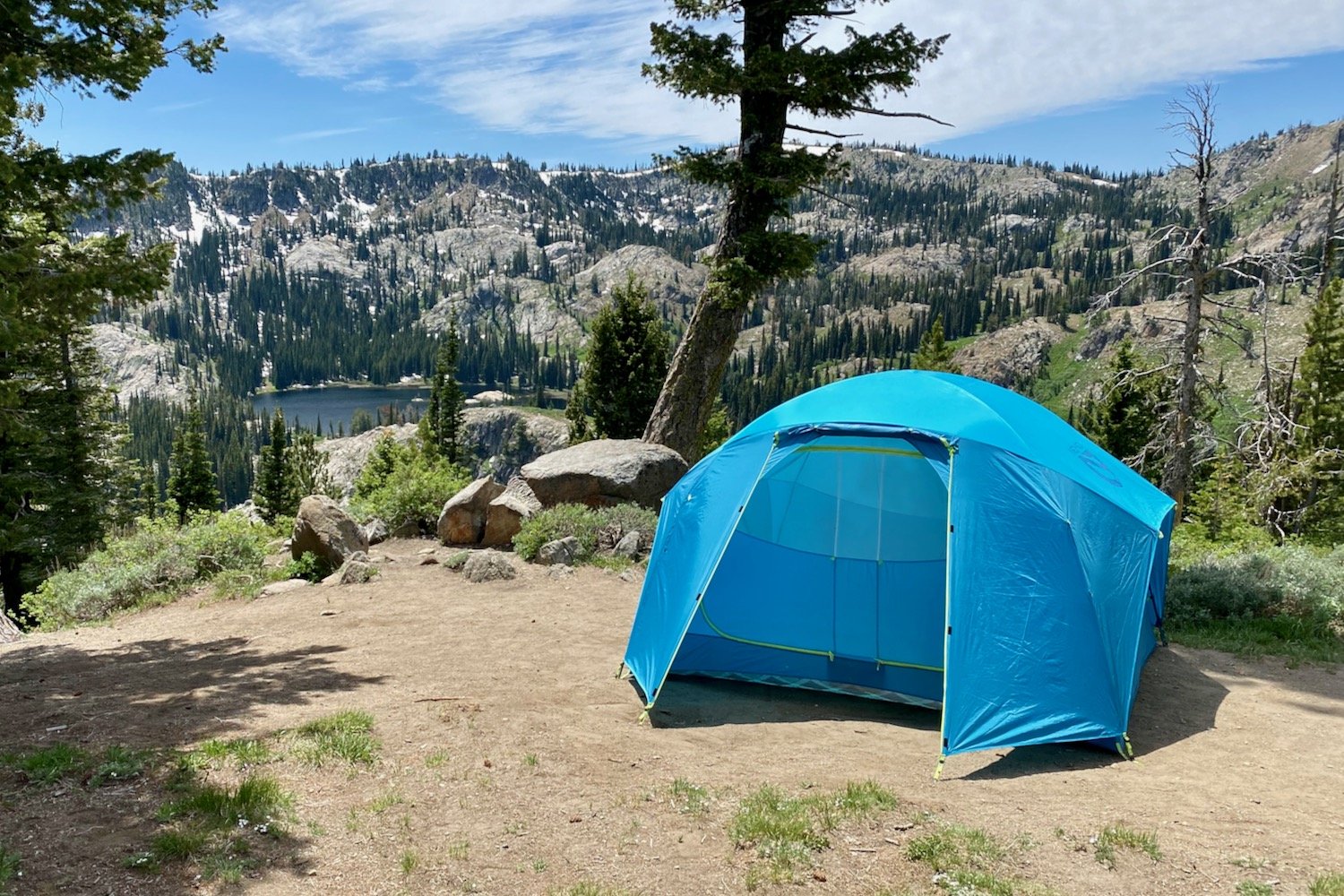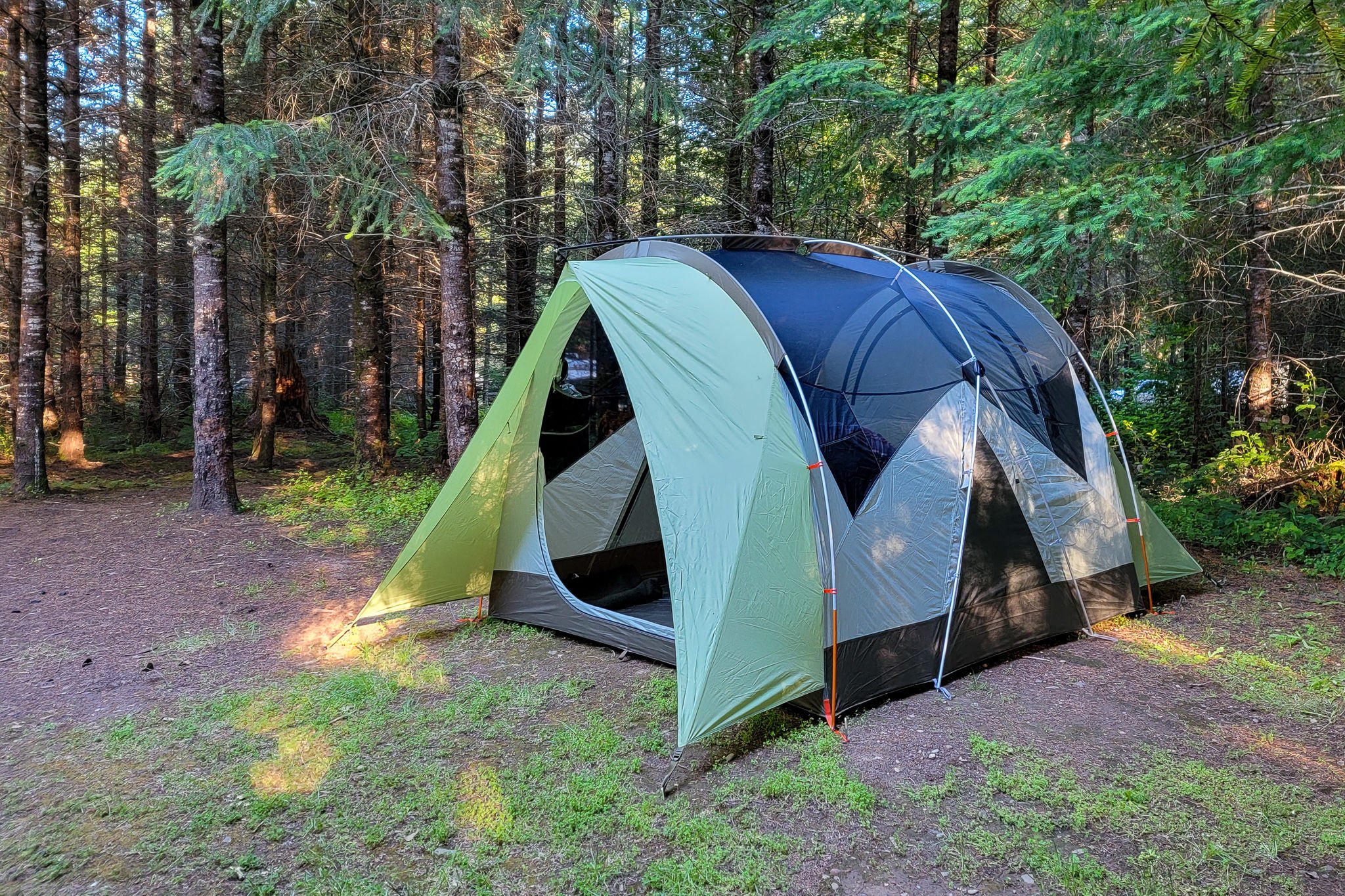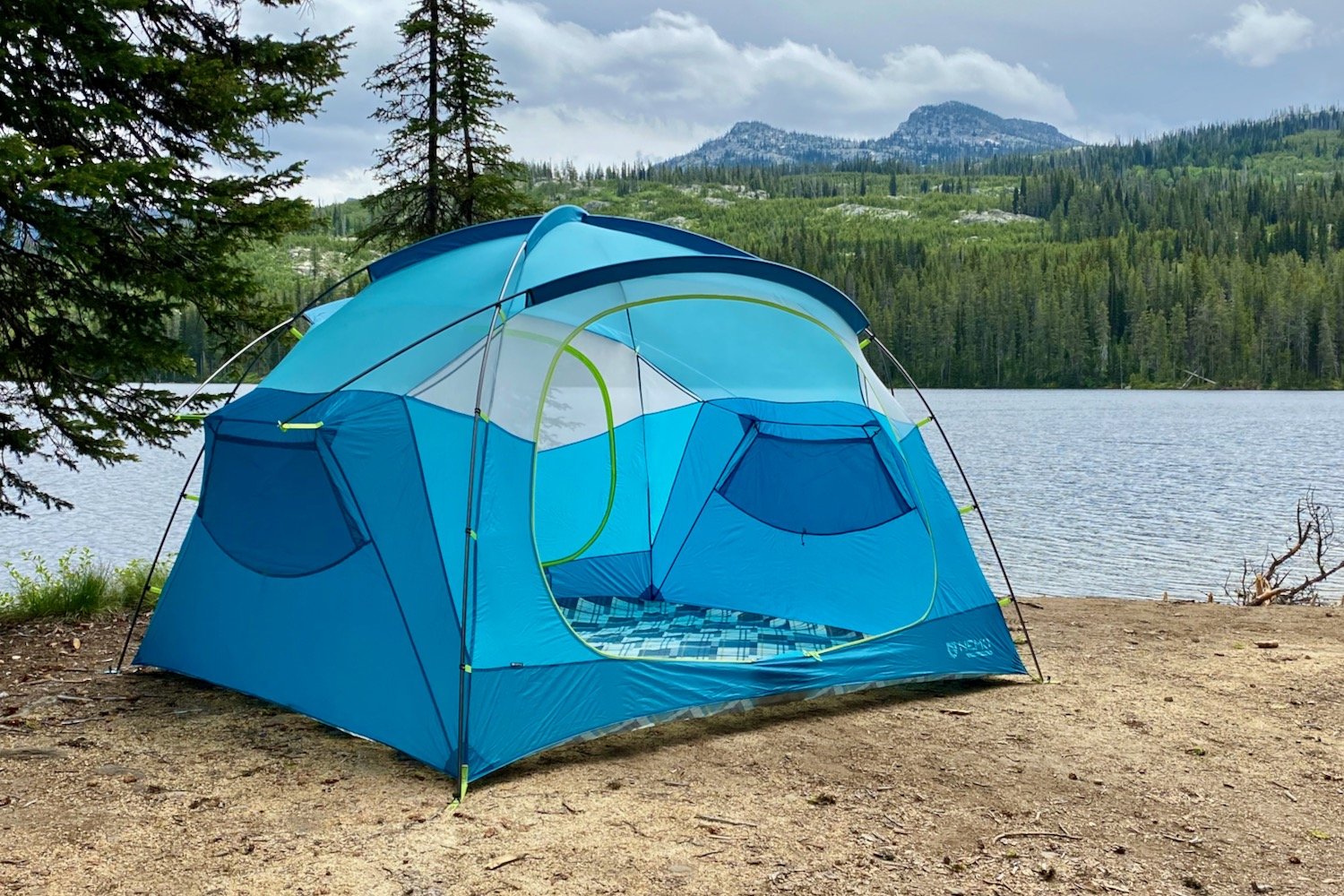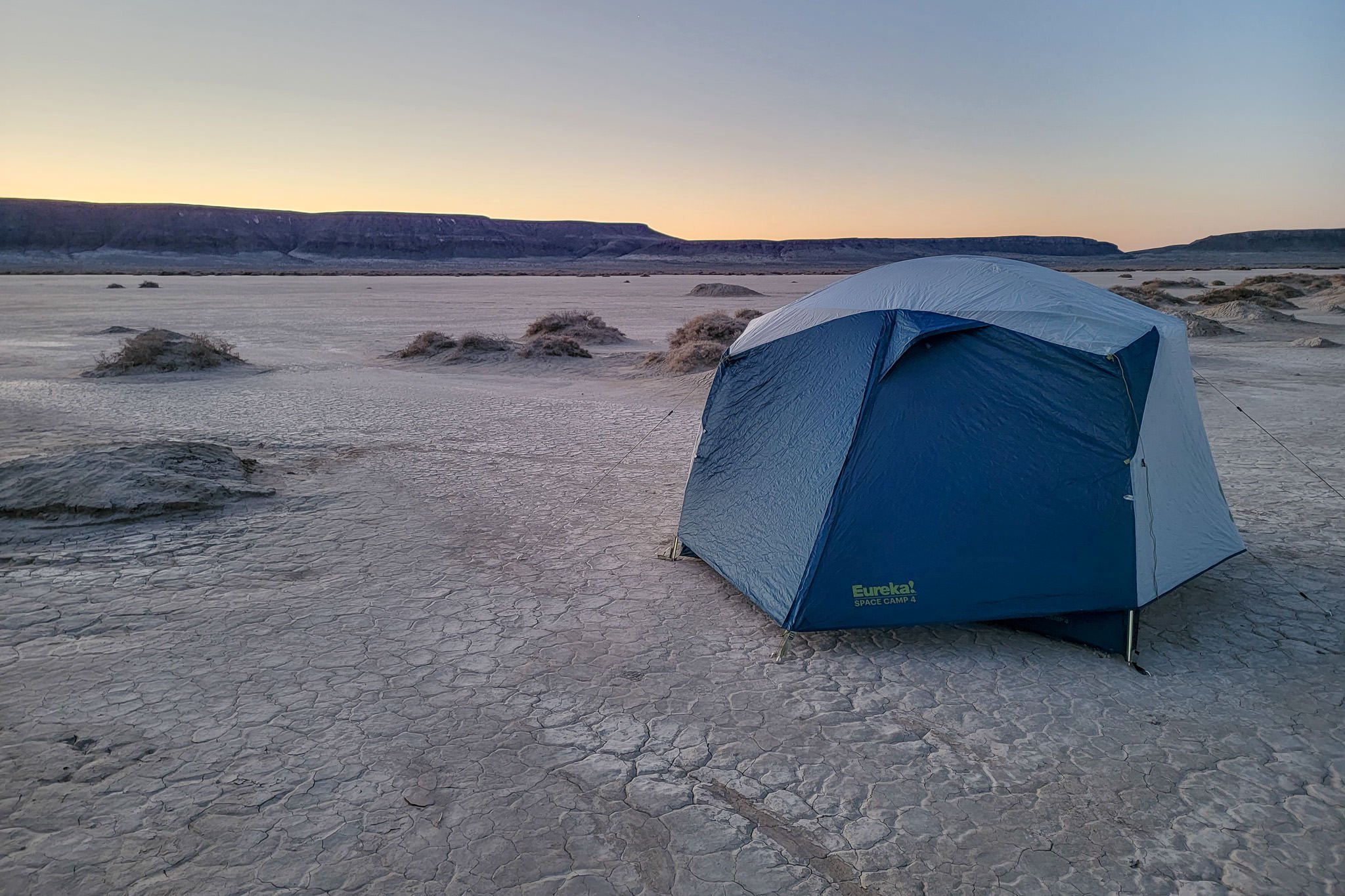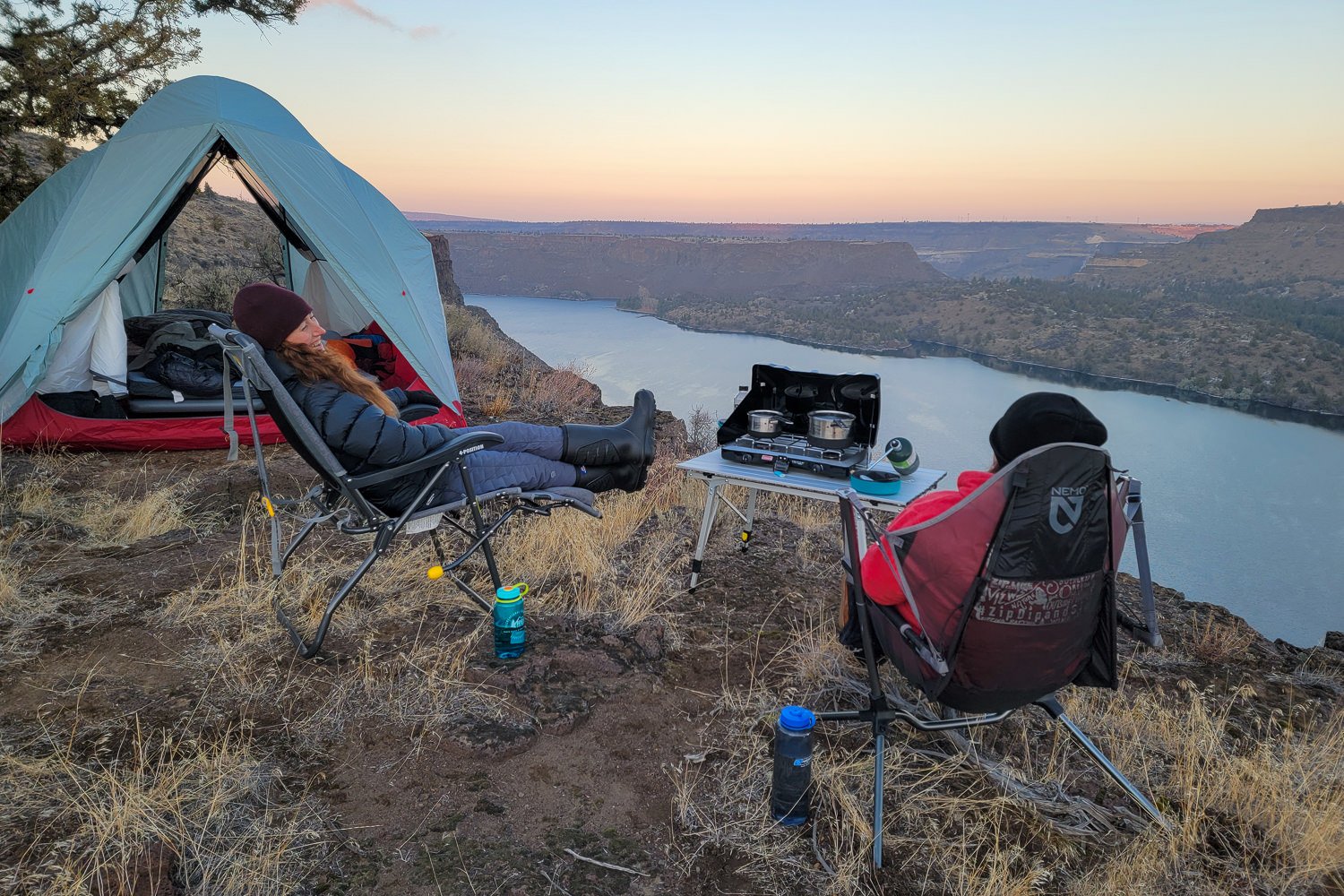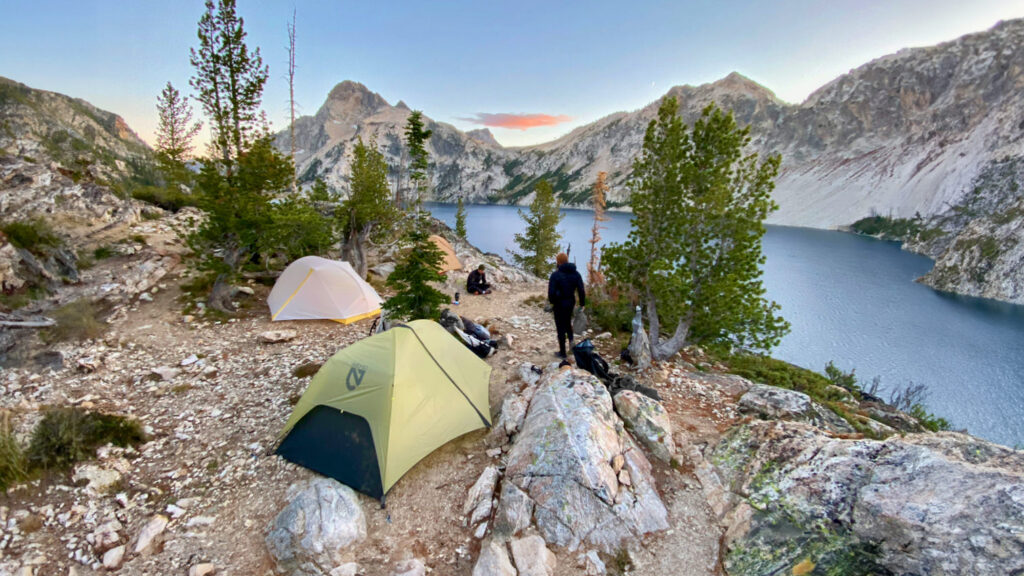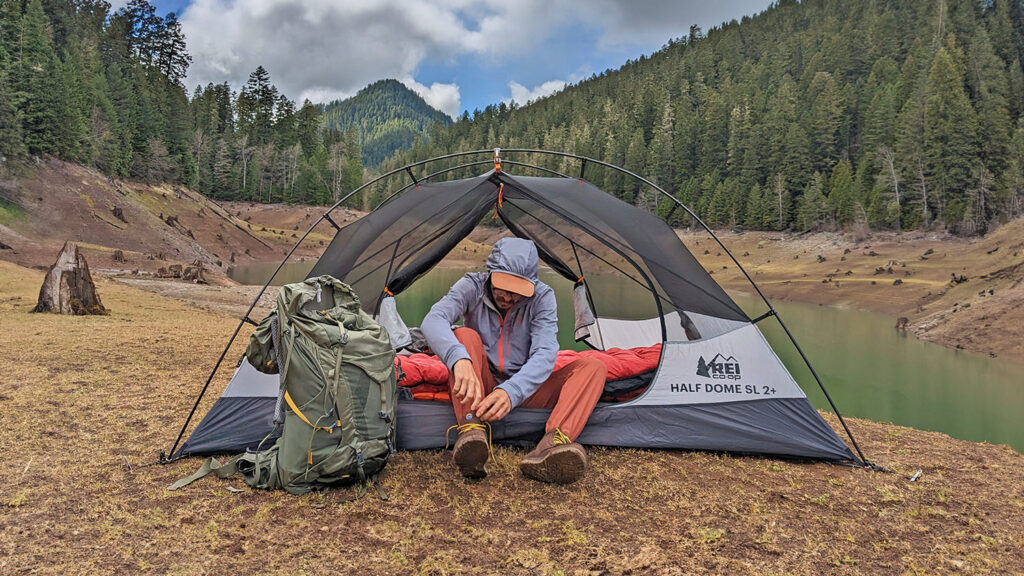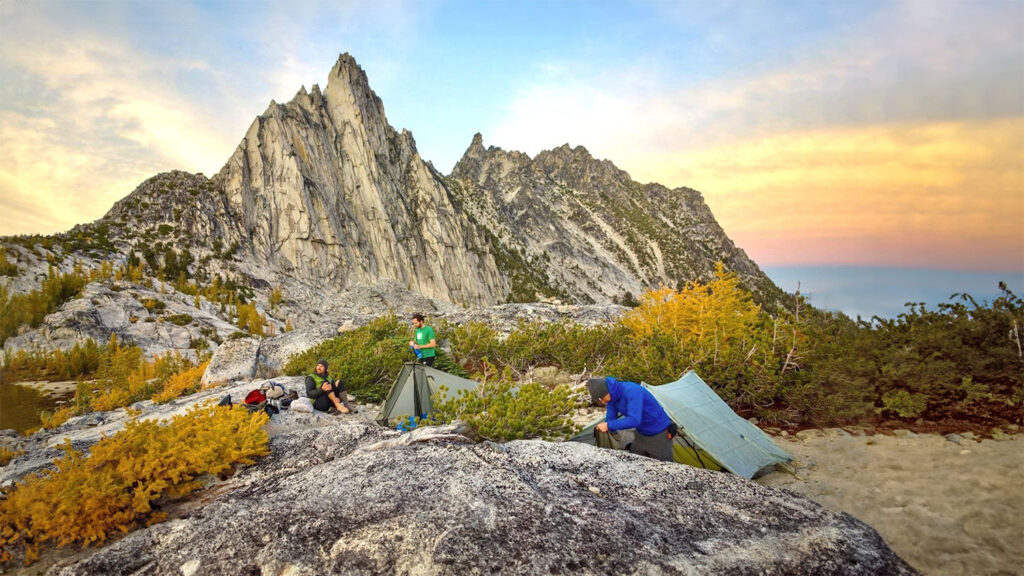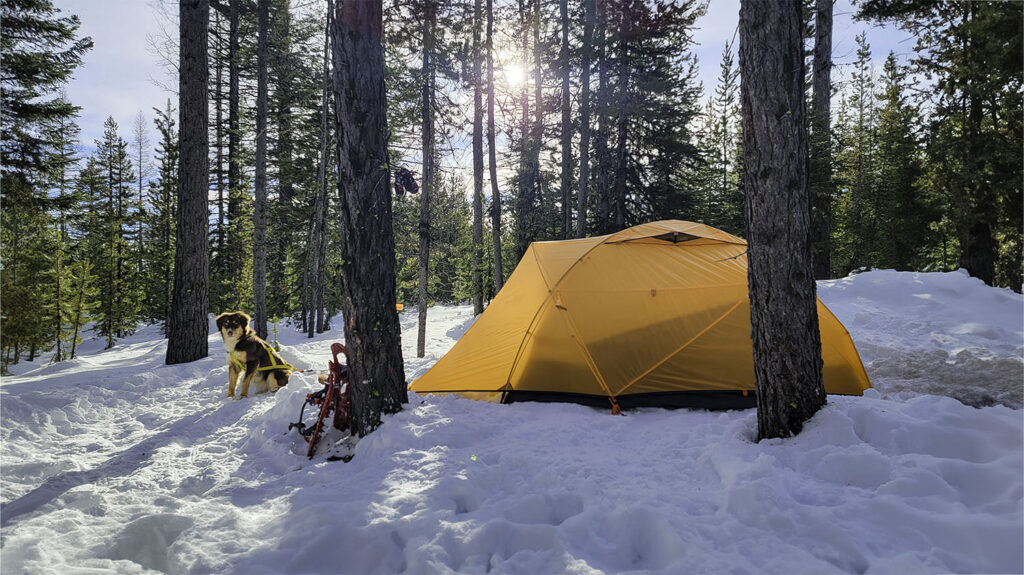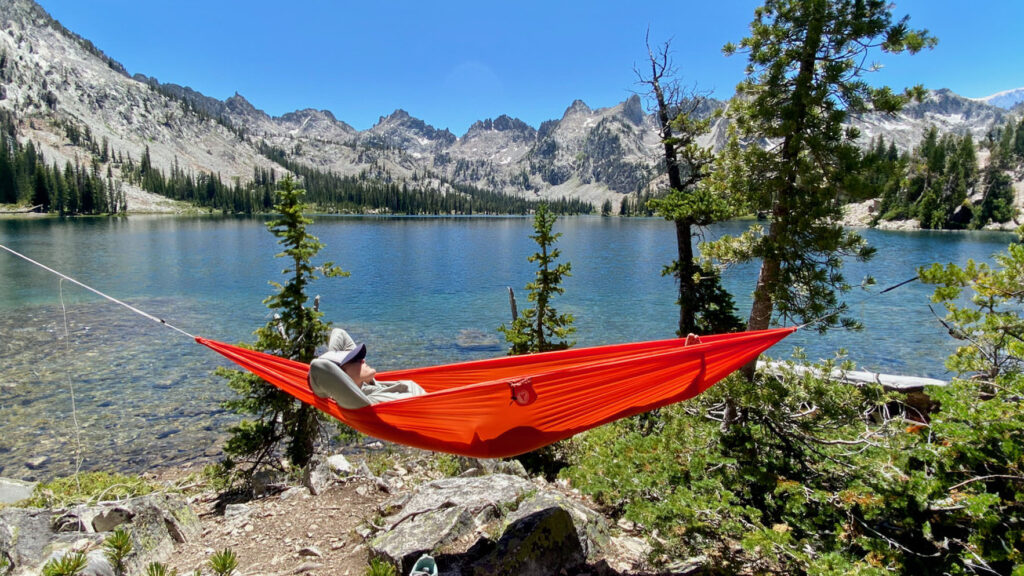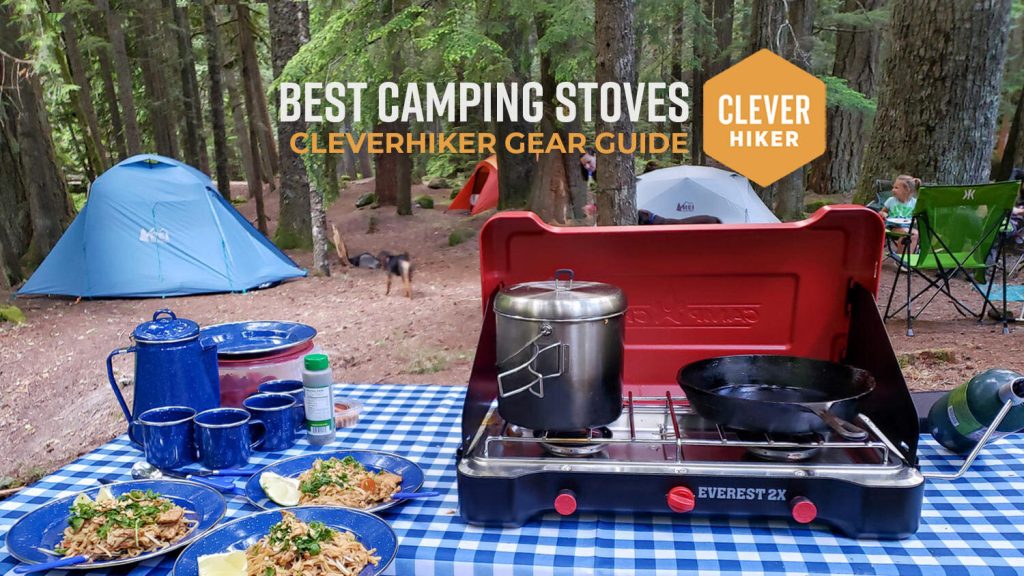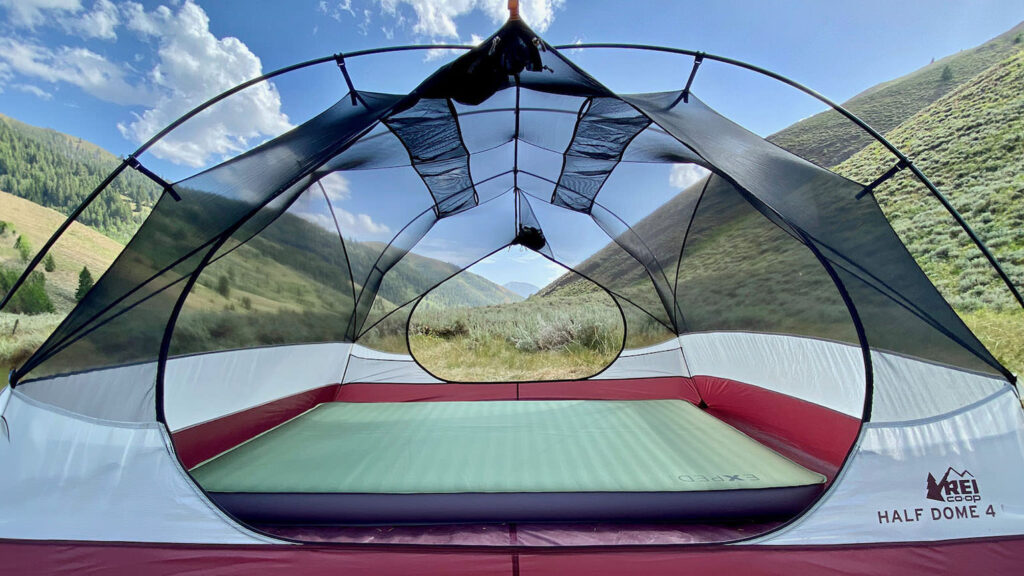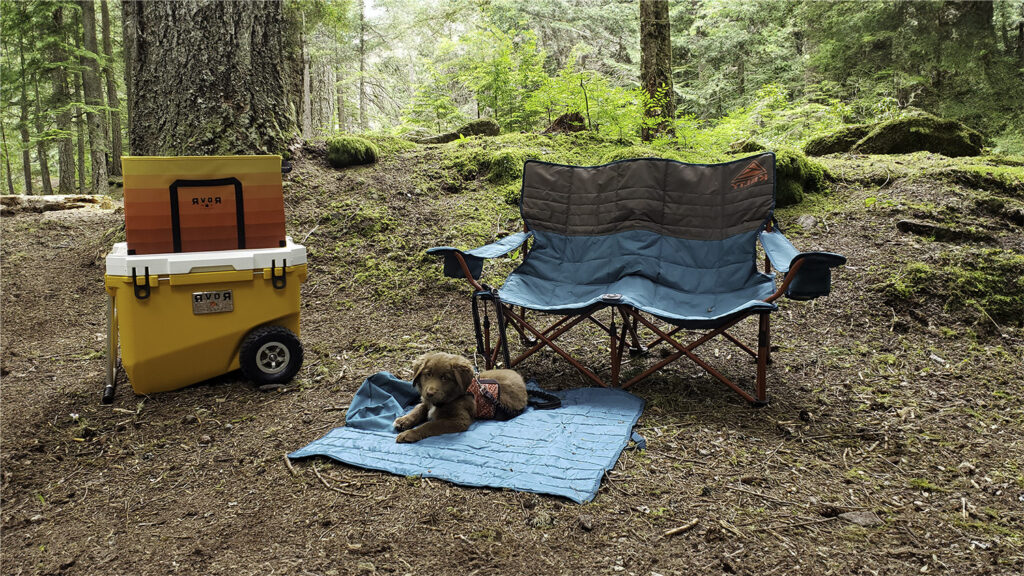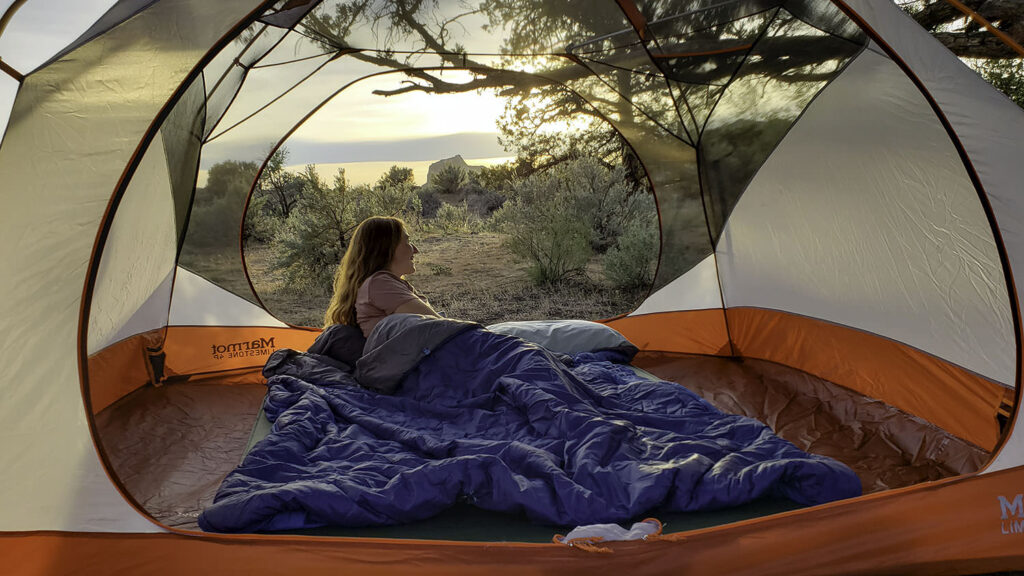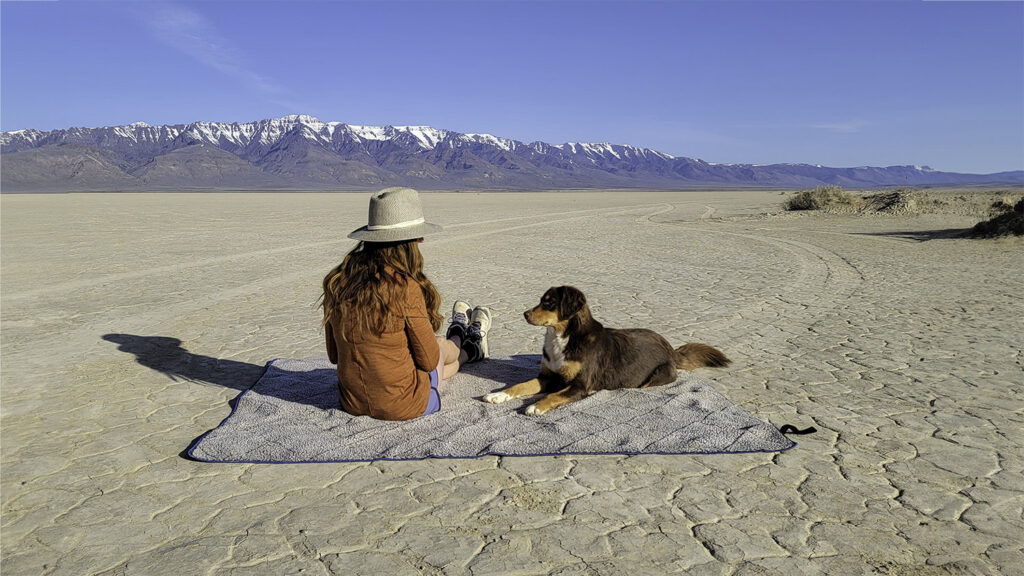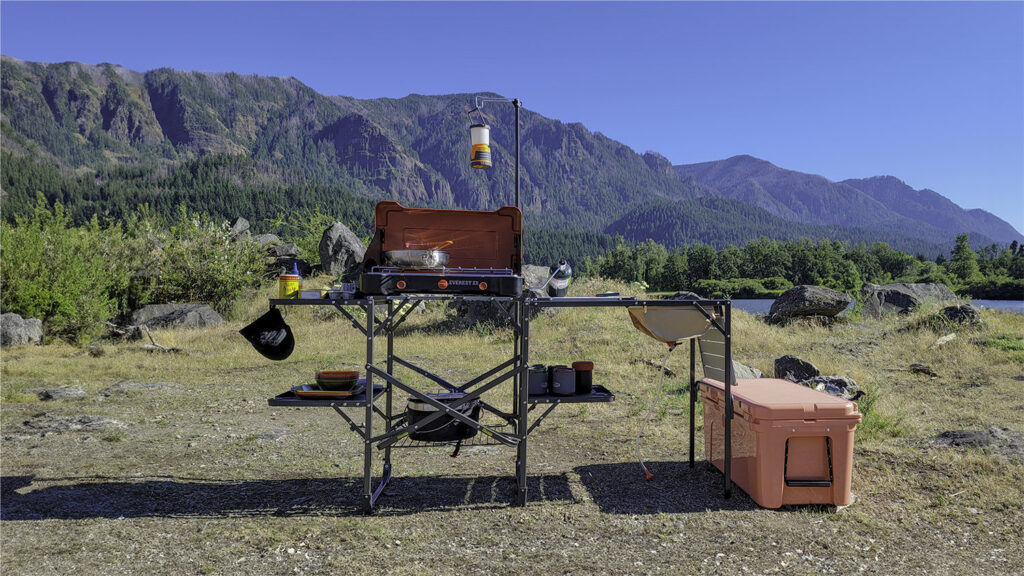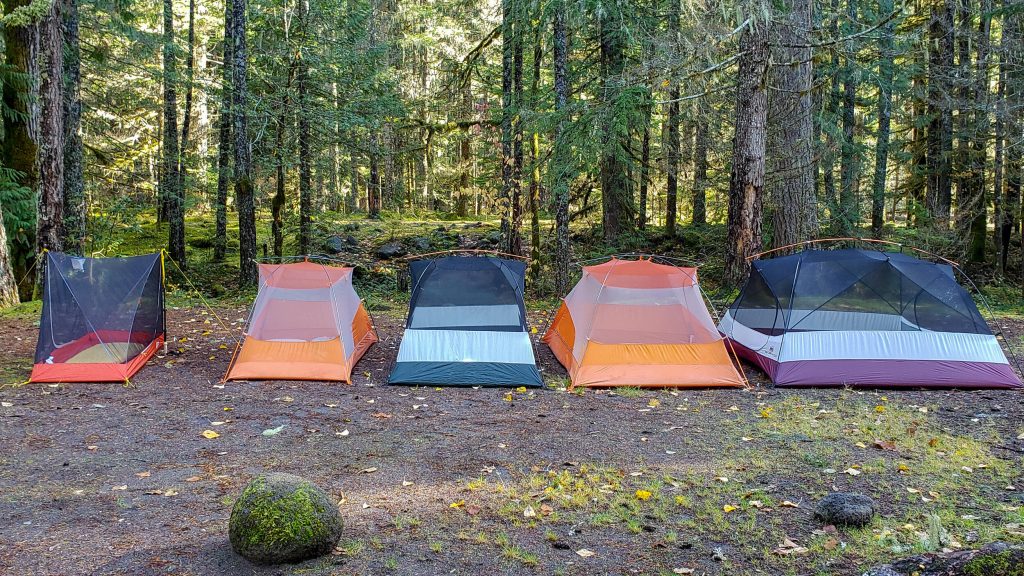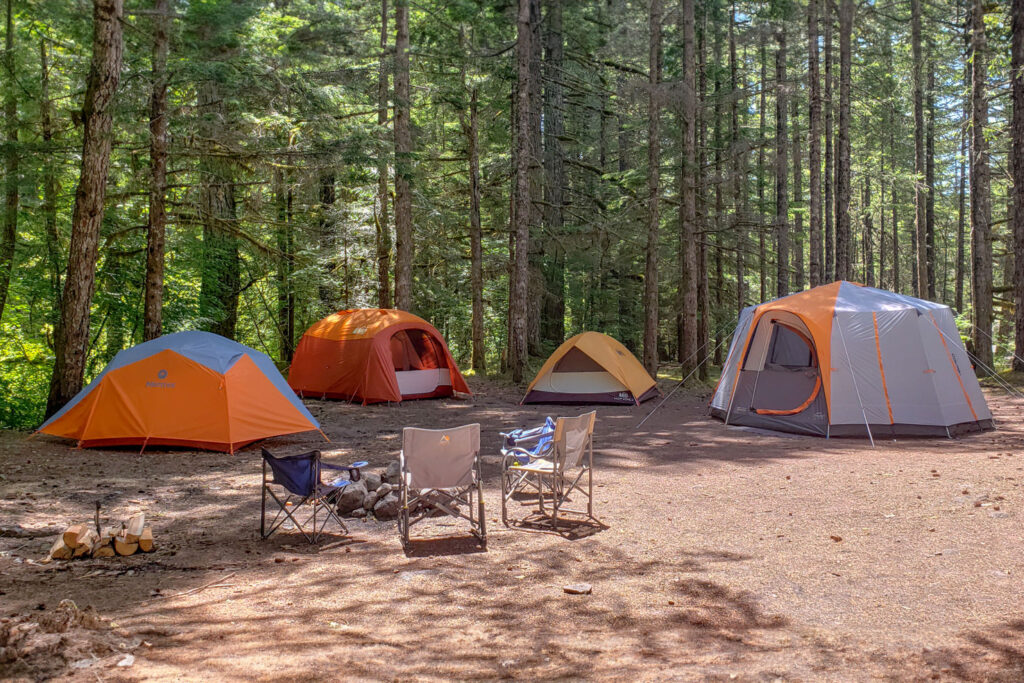
A reliable shelter is key to a safe and cozy night and we’re here to help you find the perfect tent for your next frontcountry adventure with your favorite people – and pets.
Our team of professional gear experts spent countless hours researching 50 tents to narrow down the long list to the best of the best for hands-on testing over dozens of nights of car camping. We’re confident you’ll find a tent here that’s a great fit for you: easy to set up, spacious, affordable, and comfortable to sleep in.
If you’re looking to round out your camping experience, we also recommend a high-quality camping mattress to slide inside that home away from home. For lighter-weight pursuits, we’ve also tested and reviewed the best backpacking tents and ultralight shelters for those headed into the backcountry.
Quick Picks for Camping Tents
Check out this quick list of our favorite camping tents, or continue scrolling to see our full list with in-depth reviews.
Best camping tent overall: REI Skyward 4 ($374)
High-quality & durable tent for two: Mountain Hardwear Mineral King 3 ($375)
Best luxury camping tent: REI Wonderland 4 ($499)
Best bang for your buck: Kelty Wireless 6 ($280)
Easy to set up & made with high-quality materials: NEMO Aurora Highrise 4 ($400)
Best crossover choice for camping & backpacking: REI Half Dome SL 3+ ($399)
Sturdy & comfortable tent with a large vestibule: The North Face Wawona 6 ($500)
Best low-profile, high-volume camping tent: Marmot Tungsten 4 ($399)
Budget tent with a partial rainfly: Coleman Sundome 4 ($100)
What’s new
Our team of gear testers spent night after night in the woods testing out these new tents and pitting them against our trusted favorites:
- The Mountain Hardwear Mineral King 3 takes the #2 spot for its durable build, huge doors, and excellent ventilation.
- The Kelty Wireless 6 earns a spot as a cost-effective, colorful, and spacious tent that’s easy to use and fast to pitch.
- We added The North Face Wawona 6 as a stellar basecamp due to its huge vestibule that doubles as a gear garage and living room.
- The Marmot Tungsten 4 makes its way onto the list for its low profile, simple design, and relatively low weight.
- And say hello to the impressively weather-resistant and roomy MSR Habitude 6, a pricey but super high-quality tent.
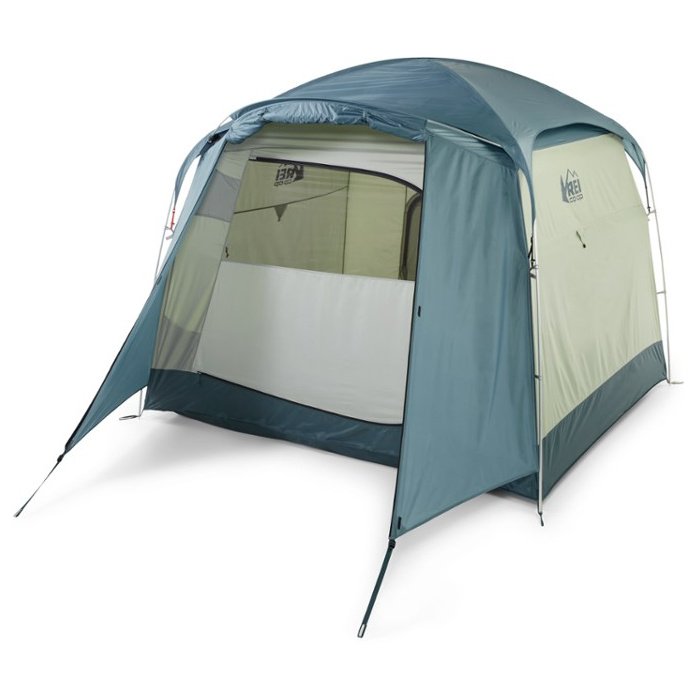
REI Skyward 4
Best camping tent overall
Price: $374
The size we tested feels: Luxurious for 2, comfortable for 3 & tight for 4
Weight: 13 lb. 11 oz.
Dimensions (LxWxH): 100 x 86 x 78 in.
Pros
- High-quality poles & materials
- Room to stand
- Quick/easy set up
- Large D-shaped door
- Nearly vertical walls
- Detachable vestibule
Cons
- Not as stable in high wind
- Guylines not pre-attached
- No window flap ties
When it comes to front-range camping tents, the REI Skyward 4 is one of our all-time favorites. That’s why it earns the top spot as the Best Overall Camping Tent of 2024. The Skyward’s high-quality tent poles and fabrics, spacious interior, and ease of setup put it at the front of the pack as an outstanding option for families, couples, and groups.
The Skyward has near-vertical walls and an impressive 6.5-foot peak height, so even the tallest folks can stand, dress, and move around freely. The enormous D-shaped door with its smooth zipper makes schlepping gear in and out of the tent no problem, and the windows offer plenty of airflow and views. The storm flap creates protection from the elements when you need it. The walls are solid material, not mesh, so you’ll have plenty of privacy as well.
What we love most about the Skyward is the practical and familiar design. There are many well-placed mesh pockets throughout the tent for storing bulky items like coats or gloves, and smaller items like a watch or lighter. The huge mesh ceiling offers plenty of ventilation and outstanding views of the stars on balmy evenings, or you can quickly snap the burly rainfly back on when storms roll in. And, the vestibule is large and adds plenty of privacy and gear storage. We like the huge, roll-up garage-style vestibule door for easy access to gear and fast in-and-out to the tent.
Like most tall tents, the Skyward has a bulky profile that doesn’t handle strong winds as well as a lower-profile option. That said, if you tend to set up camp in sheltered locations (like most front country campsites), this won’t be an issue. Also, REI doesn’t include ties for the window coverings, so the solid panels that cover the mesh of the windows are left hanging open and can get in the way.
However, the Skyward is one of our team’s go-to tents year after year – it’s incredibly fast and intuitive to set up, great for car camping and groups, and the awning over the door lends a welcoming and homey feeling every time we set it up. This REI offering is a well-rounded tent with a sweet balance of simplicity, spaciousness, and relatively compact packed size.
Full review: REI Skyward 4
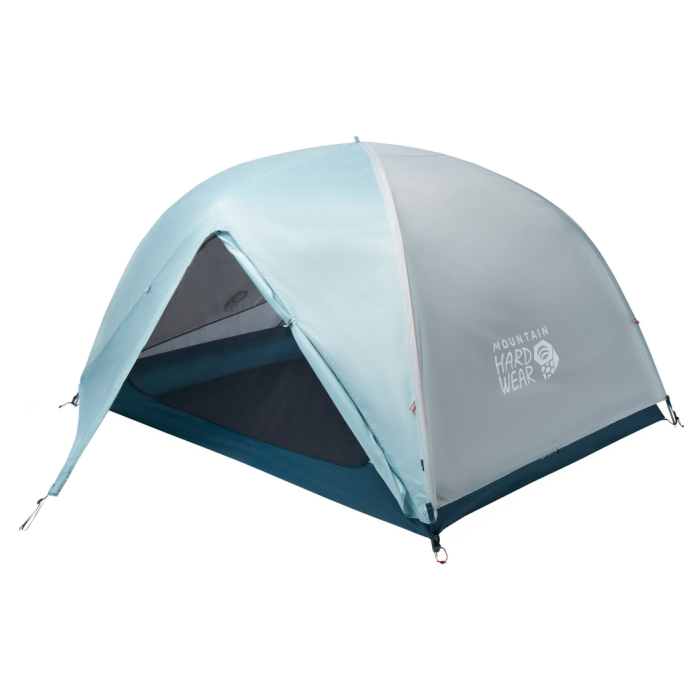
Mountain Hardwear Mineral King 3
High-quality & durable tent for two
Price: $375
The size we tested feels: Luxurious for 1, comfortable for 2 & tight for 3
Weight: 12 lb.
Dimensions (LxWxH): 90 x 68 x 48 in.
Pros
- Lightweight
- Easy and intuitive to pitch
- Huge doors with out-of-the-way stuff pocket
- Pre-bent poles create plenty of internal room
- Dual zippers on fly with kickstand for ventilation
- Fly rolls up halfway
- Plenty of pockets
- Packs small
Cons
- Lower peak height
- All-mesh upper limits privacy without fly
- Heavy for its size
The Mountain Hardwear Mineral King 3 is a dream for summer camping. Thanks to its all-mesh upper, versatile fly design, and enormous doors, this high-quality and familiar tent design feels like a castle for one person, or a cozy shelter for two.
We love the Mineral King 3’s all-mesh canopy and smart fly design for its breathability in the summer. There’s almost no nylon on the interior walls of the tent, so it offers unrivaled ventilation on warm trips where a cool breeze at night is a priority. Plus, the tent fly can be rolled up halfway to the center of the ceiling so you can take in the views of the Milky Way at night. Or the fly can be quickly rolled back down when wet weather moves in.
The Mineral King is as livable as 3-person tents come. The pre-bent poles make for a fast and easy pitch and the five pockets offer all the storage we want. Tall dual kickstands and double zippers on the rainfly doors keep the rain out while allowing for good ventilation when conditions are muggy.
This model offers the widest doors of any 2- or 3-person tents we’ve tested. They span almost the entire length of the interior tent on both sides, so accessing gear is a breeze. When open, the mesh doors stash easily in a smartly placed pocket to keep them off the ground or the inside of the tent. We like this design and generally prefer stuff pockets for door flaps so we’re not constantly fiddling with tabs and loops to keep the doors open.
Our biggest gripe with this tent is its low ceiling height. At 48 inches, it’s one of the lowest peak heights on this list, so you’ll want to keep looking if standing up inside your shelter is a top priority. That said, the Mineral King offers plenty of headroom for two people to sit up and move around without feeling cramped. Plus, this low profile is advantageous in summer storms. When driving rain and whipping wind pick up, the Mineral King feels secure and will reliably keep you and your gear bone dry.
Though the Mineral King 3 is a bit heavy for its size, this tent is tough to beat when it comes to a well-ventilated, easy-to-use shelter for one or two people looking for a 3-season car camping option. If you need a shelter that packs small, has plenty of storage, and is built to last season after season, this is the tent for you.
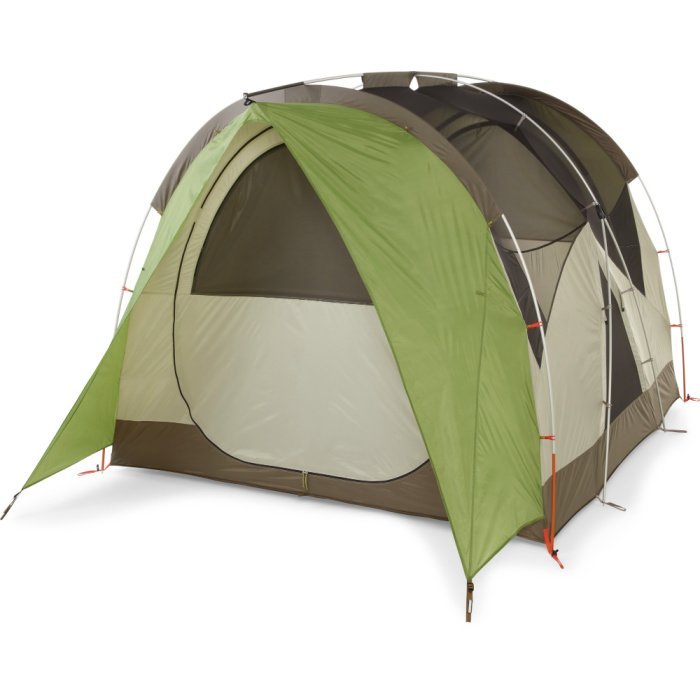
REI Wonderland 4
Best luxury camping tent
Price: $574
The size we tested feels: Luxurious for 2, comfortable for 3 & tight for 4
Weight: 21 lb. 11 oz.
Dimensions (LxWxH): 120 x 100 x 75 in.
Pros
- Room to stand
- High-quality poles & materials
- 2 large doors
- Color-coded tabs for easy setup
- Tons of pockets
- Large vestibule
- Smart vent locations reduce condensation
- Awnings over doors
Cons
- Expensive
- Heavy
- Footprint sold separately
- Not as sturdy as others in strong wind
“Luxury” and “camping” are two words we rarely put together, but the REI Wonderland 4 bridges the gap. It’s our pick for the best luxury tent because of its cavernous interior, giant doors at both ends, and a generous number of storage pockets to keep your tent feeling organized and tidy.
The Wonderland boasts a distinctive pole design, creating a spacious rounded tunnel shape that makes the tent feel huge. Despite its unusual look, the smart color-coding on the tabs, tent, and poles makes setup fast and easy – we find two people can pitch the Wonderland in less than three minutes. Its 75-inch peak height offers tons of room to stand up, get dressed, and organize gear in an upright posture for most people without ever needing to step outside.
The Wonderland is fully rain-ready with sealed seams, a protected front entryway with an effective awning, and a huge vestibule for storing wet gear. This model also has a scalloped fly with protected windows, so you can see outside and still enjoy plenty of ventilation even if it’s raining out.
Our primary issue with the Wonderland is its weight – at over 21 pounds, this is one of the heaviest tents we’ve tested. However, we’re not backpacking with this tent, and despite its heft and large footprint, you’ll be hard-pressed to find a more durable option anywhere. From its beefy poles and thick fabric to the double-stitching and outstanding pockets, the Wonderland’s weight is worth every ounce for a tent that’s built to last. As a bonus, it packs down to a very manageable size and fits well into a compact case for easy carrying.
The Wonderland is a very close sibling to the REI Skyward – our best tent overall – but the higher price tag keeps it from the number one slot. The Wonderland is a smart, roomy shelter that comfortably fits two to three people who prioritize comfort and durability for easy, organized summer camping.
Full review: REI Wonderland 4
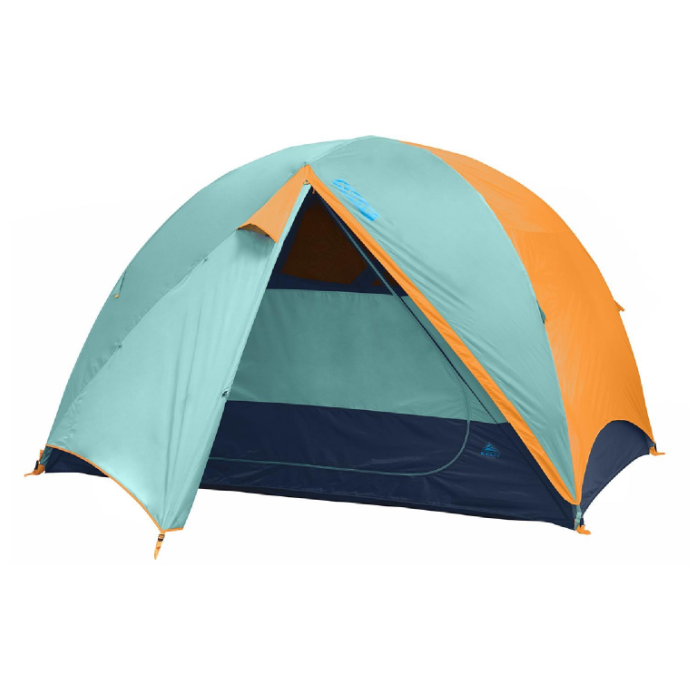
Pros
- Huge interior
- Color-coded tabs for easy setup
- Less expensive
- Intuitive and fast to pitch
- Multiple sizes
- Excellent carrying case
Cons
- Footprint sold separately
- Only a few small internal pockets
- Doesn’t ventilate well
We welcome the Kelty Wireless 6 to our list as a spacious and feature-forward shelter for six people, and one of our new favorite budget tents of the year. In a market where most tents cost well over $300, including much smaller-sized options, the Wireless 6 is an economical breath of fresh air that offers everything you need and nothing you don’t.
It has a ton of interior room. With a 76-inch peak height, the Wireless offers one of the highest ceilings on this list, so you won’t have to stoop while you’re inside. The long brow pole pulls the interior walls taut and nearly vertical, increasing the livable space. We found there’s more than enough room to fit a family of four without feeling crowded, and for two people and a dog, it’s downright grand.
We like the Kelty Wireless for its cheerful and colorful aesthetic, but it’s more than just pleasing to the eye: the tent is color-coded to make pitching fast and easy. One of our favorite features is the deep pole pockets, which replace the need to carefully place pole tips in small grommets during setup. Simply nestle the poles in the tall pockets to keep them securely lodged as you clip the rest of the tent onto the frame.
Weighing in at over 17 pounds, the Wireless is one of the heavier tents we tested, although we can forgive the weight because it’s fairly durable. The seams are taped, the buckles are large and strong, and once staked, this tent is secure in any typical summer storms that roll through.
Our biggest complaint is the lack of ventilation in the Wireless. It features only two vents located on the downslope of the doors, and the interior has limited mesh. We wouldn’t recommend this model for camping in continually humid and muggy places due to condensation buildup – but for most summer camping conditions, we think it’s a great choice.
If you’re looking for a tent with large vestibules, a big living space, and one of the easiest-to-use carrying cases we’ve seen, the Kelty Wireless 6 is a real bargain for less than $300. Plus, this series comes in 2-person, 4-person, and 6-person versions, so you can find the perfect size for your next car camping adventure.
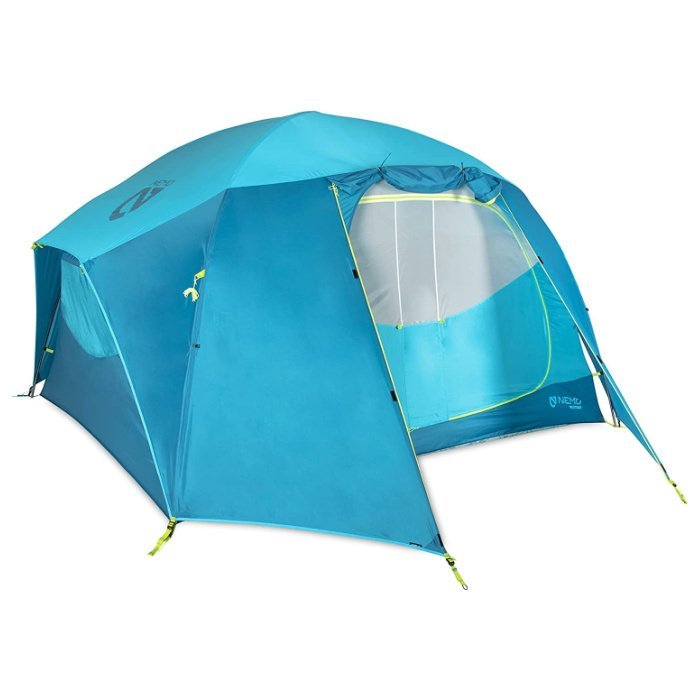
NEMO Aurora Highrise 4
Easy to set up & made with high-quality materials
Price: $400
The size we tested feels: Luxurious for 2, comfortable for 3 & tight for 4
Weight: 15 lb. 14 oz.
Dimensions (LxWxH): 100 x 90 x 75 in.
Pros
- High-quality poles & materials
- Two enormous doors with stuff pockets
- Fast & easy setup
- Large livable space
- Excellent ventilation
- Durable construction
- Relatively compact when collapsed
Cons
- Only half door in the back
- Carrying case is tight
The NEMO Aurora Highrise 4 continues to impress us because of its durable build, huge interior space, and versatile design. For couples or families looking for a camping shelter that’s both spacious and easy to set up, look no further than the Highrise 4.
We love the giant door on the front, and that it stuffs away into a small, non-intrusive pocket. While the rear door is quite a bit smaller, we’ve found it doubles as an extra-large vent to keep air moving.
The sturdy white mesh of the Highrise also sets it apart. It allows you to see out of the windows on all four sides, even when it’s raining but still offers remarkable privacy.
The pole structure of the Highrise is unusual compared to other tents this size, so there’s a bit of a learning curve the first couple of times you set it up – but it’s a snap to pitch after that. The walls are steeply inclined, so you can stretch as wide and tall as you want in the morning and not touch the ceiling. And it’s plenty durable, so it’ll last for many years if you treat it with care.
Our main complaint about the Highrise is the carrying case – we like when a tent is easy to store once it’s rolled up, but the Highrise comes with a smaller stuff sack and takes some extra work to fit everything in.
That said, the Highrise offers an outstanding value considering comfort, size, and durability. You can get the 6-Person Aurora Highrise for the same price as the smaller version of comparable tents, so we think it’s an excellent value.
Full review: NEMO Aurora Highrise 4
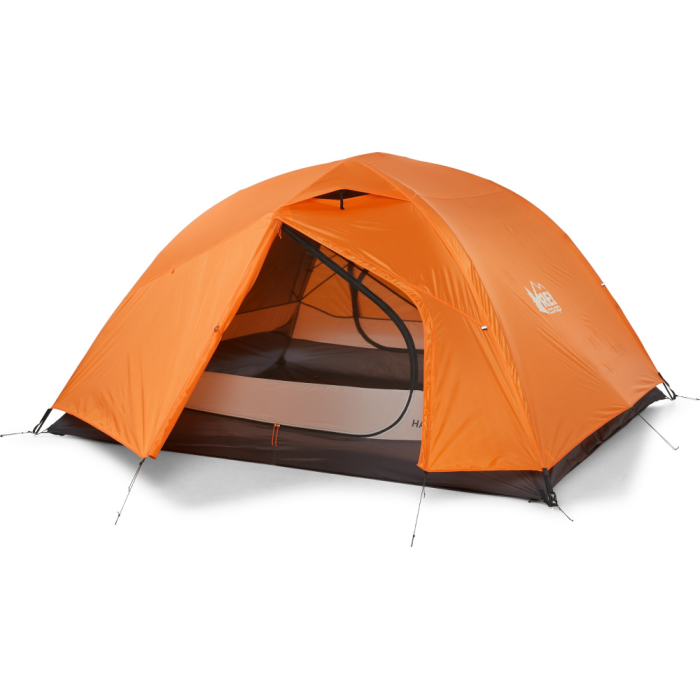
REI Half Dome SL 3+
Best crossover choice for camping & backpacking
Price: $399
The size we tested feels: Comfortable for 2, tight for 3
Weight: 5 lb. 11.7 oz. (with footprint)
Dimensions (LxWxH): 90 x 78 x 44 in.
Pros
- High-quality poles & materials
- Quick & easy setup
- Lightweight
- Compact storage
- Two doors & vestibules
- Smooth zippers
- Good ventilation
- Good pockets
- Footprint included
Cons
- Low peak height
- Guylines not pre-attached
- Not enough stakes or guylines
We’re big fans of the REI Half Dome SL tents, and they’ve ranked at the top of the list for years. If you prefer the convenience of a low-profile and compact camping tent, but you still want the option to do some backpacking, the Half Dome series is a fantastic choice.
The Half Dome is not as spacious as most camping tents on this list. However, it’s much roomier than an average backpacking tent thanks to pre-bent poles that create vertical sidewalls. This translates to a ton of headroom, and lots of space to sit up and move around when sharing space with a furry friend or a hiking partner.
REI doesn’t cut corners on the essential features – the Half Dome offers a few well-placed pockets for stashing your phone or a headlamp, lots of floor space, and wide vestibules for any gear you want to keep close and out of the elements. It uses a time-tested design and familiar cross-X setup with a beefy brow pole, so it’s super fast to pitch and tear down.
Our favorite thing about the Half Dome is its versatility. It’s just light enough to take on short backpacking trips while being spacious enough for car camping. Even for the 3+, the split weight comes out to just under 3 pounds, which is reasonable for a backcountry weekend adventure.
This tent is more stable in high winds due to its lower profile and it’s very easy to pitch and take down. The Half Dome is a solid tent that feels comfortable, comes at a great price, and performs well in any weather.
Full review: Half Dome SL
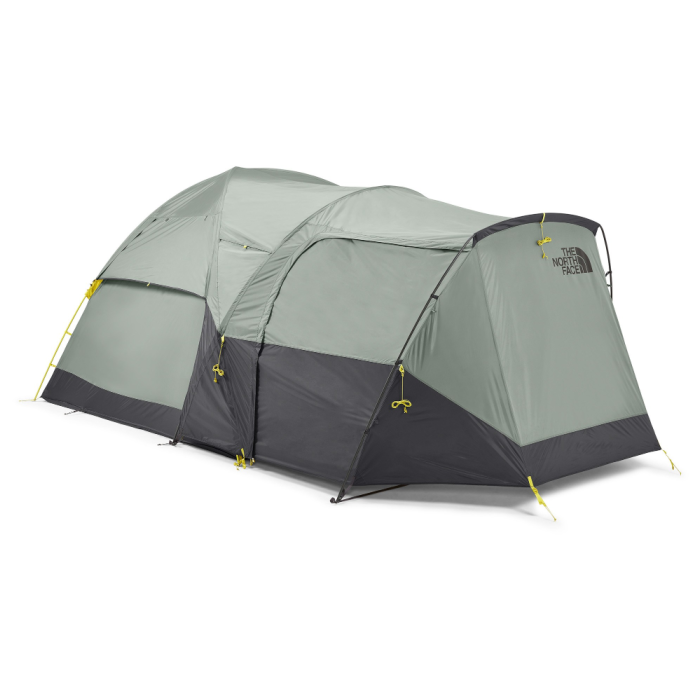
The North Face Wawona 6
Sturdy & comfortable tent with a large vestibule
Price: $500
Size: 6-Person
The size we tested feels: Luxurious for 3-4, comfortable for 5 & tight for 6
Weight: 21 lb. 14 oz.
Dimensions (LxWxH): 120 x 96 x 76 in.
Pros
- High-quality fabric & poles
- Huge interior space
- Smart pockets & organization
- Many guyline attachment points
- Tall ceiling
- Massive vestibule
- Effective vents
Cons
- Heavy
- One door
- Takes time to pitch
- Footprint not included
If you’re looking for a tent with the largest vestibule for your family outings, a summer trip with a group of friends, or adventures with lots of gear, The North Face Wawona 6 is your golden castle. Its vestibule, clever interior design, and outstanding ventilation make for a very comfortable place to sleep, hang out, and stage your next activity.
When it comes to vestibule size, The Wawona is in a class of its own: the front vestibule is a whopping 44 square feet at the front, creating an entire additional covered space big enough to sleep in, and a substantial rear vestibule offers an equally impressive 21 square feet.
Not only are these spaces ideal for stashing the typical muddy shoes, wet gear, and bulky items like backpacks, but the spacious vestibules can accommodate multiple bicycles, bins of gear, or up to three camping chairs and a small table to relax during a rainy afternoon. Although neither vestibule has a screen to keep out bugs, we don’t mind too much.
We appreciate the plentiful pockets and different-size storage pouches throughout the tent for stuffing everything from light jackets and hats to lighters and charging wires. Extra features like a lantern loop in the center ceiling, color-coordinated poles for easy setup, plus an all-mesh door and vent kickstands keep air moving and prevent condensation from building up on humid nights.
Having said that, we found the Wawona a bit cumbersome and time-consuming to pitch, even after we’d mastered each step of setup, so we highly recommend finding an extra set of hands to help speed up the process. The tall height of the tent makes it vulnerable in high wind, so knowing how to secure it properly is essential for wind and storms.
The biggest con of the Wawona 6 is its price and weight. At $500, this is one of the priciest camping tents we tested – and one of the heaviest as well. That said, we don’t carry it too far from our vehicles, and it offers outstanding value. The excellent use of space and storage, durable build, and versatile, oversized vestibules make it an unmatched basecamp tent for two to five people and a dog.
The generous 76-inch ceiling height, burly aluminum poles, and enormous vestibule could make this your go-to tent for years to come. If you’re the type of camper who likes to set up for days at a time (or longer) and satellite from that location for your outdoor adventures, this option is worth every penny.
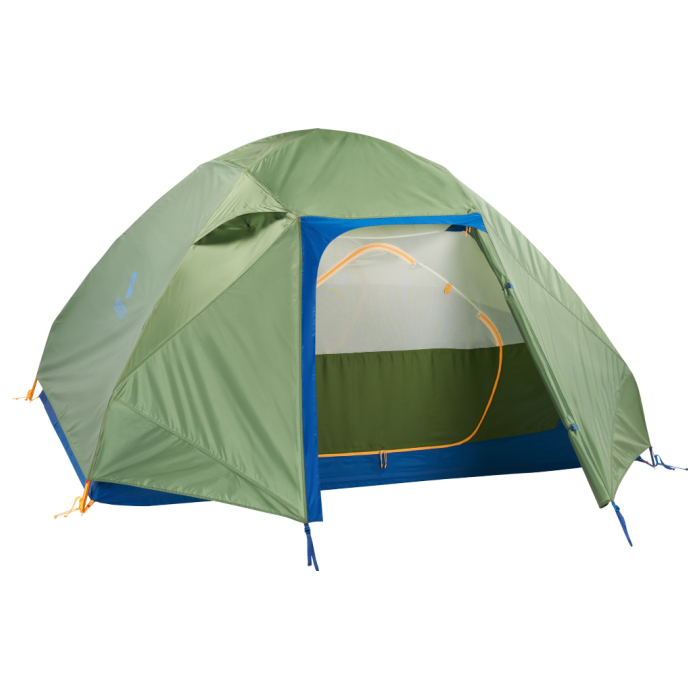
Marmot Tungsten 4
Best low-profile, high-volume camping tent
Price: $399
Size: 1-Person, 1-Person UL, 2-Person, 2-Person UL, 3-Person, 3-Person UL
The size we tested feels: Luxurious for 2, comfortable for 3, tight for 4
Weight: 7 lb. 14 oz.
Dimensions (LxWxH): 93 x 82 x 52.8 in.
Pros
- Lightweight
- Fast & easy to pitch
- Spacious interior
- Durable materials
- Rainfly doors roll to side
- Footprint included
Cons
- Few pockets
- No guylines included
- Not enough stakes included
- Low peak height
If you’re looking for a low-profile tent that’s easy to use, fast to set up, and offers plenty of room for three people (or two people and a dog) the Marmot Tungsten 4 hits the sweet spot. It’s durable, sharp-looking, and will last for years.
The Tungsten is user-friendly and simple to pitch. We found two people can set up this tent in just a few minutes, but one person can also knock out these steps with ease. The hubbed pole structure is color-coordinated and is pre-bent to tension the tent perfectly.
The Tungsten is more spacious inside than it looks. With a ceiling height of almost 59 inches, it’s not quite tall enough to stand up in for most people, but this lower profile performs better in howling winds and rain. The Tungsten’s ceiling is about 10 inches taller than the REI Half Dome, which means more room to stretch your arms when you’re waking up in the morning. Plus, this tent features two brow poles to maximize headroom when you’re sitting up and moving around.
We like the L-shape doors of the rainfly since they can be completely rolled to one side and out of the way for easy in and out. The downside of this design? You sacrifice a bit of storage space in the vestibules. There’s still enough room for shoes and a backpack, but it’s less roomy than comparable tents.
The Tungsten is lower on our list because it only has a few small internal pockets, so we quickly ran out of space to stash extra clothes and small items. And, Marmot doesn’t include any guylines with this tent. If you’re planning on camping on a windy butte in Utah or a fall storm in the high Rockies, be sure to pick up your own guylines and a few extra stakes to keep your tent securely attached to the ground.
When it comes to car camping, we love a hassle-free, reliable, and well-built tent that packs up small, and the Marmot Tungsten is a good choice. For those who don’t mind spending a bit more for a high-quality tent that feels big but packs small, this is the tent for you. And if you’re looking for a smaller size, it also comes in ultralight (for backpacking) as well as 1-, 2-, and 3-person versions.
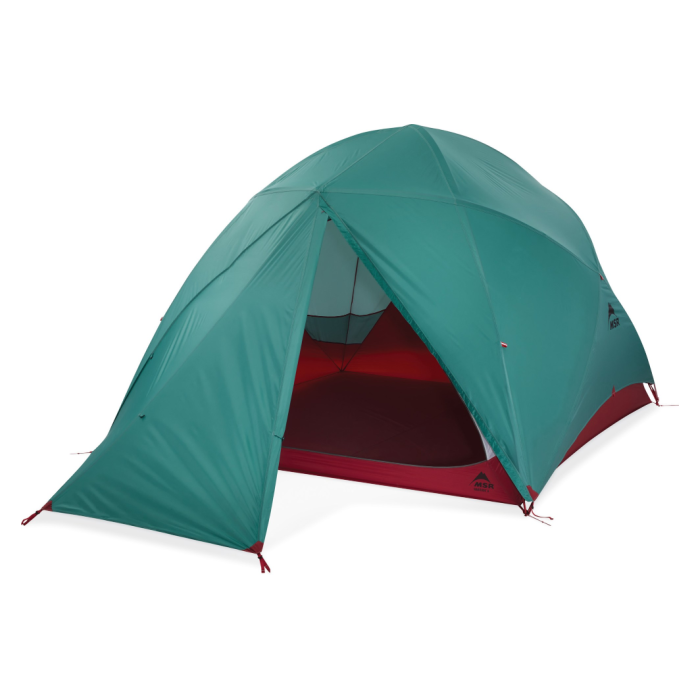
MSR Habitude 6
Best premium tent for families & groups
Price: $700
The size we tested feels: Luxurious for 3, comfortable for 4, tight for 5+
Weight: 14 lb.
Dimensions (LxWxH): 95 x 95 x 73 in.
Pros
- Top-quality build & materials
- Tall ceiling height
- Huge vestibule & interior
- Tons of pockets
- Excellent in wet weather
- Effective insulation
- Built-in “porch” light
Cons
- Very expensive
- Tough to pitch solo
- Only one door
- Small storage bag
The MSR Habitude 6 is the king of stormproof, premium tents. For families and groups who want the best of the best when it comes to 3-season weather protection and organization, the Habitude is an outstanding basecamp.
This model is impressively spacious, but the simple square design of its floor lets it fit easily into tighter campsites. We fit three wide sleeping pads with no issue, but the Habitude is more than big enough for four or five people (with regular-size pads) without feeling cramped. Plus, the peak height is well over six feet – plenty of room to stand up to change clothes.
Our favorite comfort feature of the Habitude – besides the many well-placed pockets – is the built-in “porch light”, a push-button light embedded in the aluminum poles of the awning, positioned above the single entryway. This is a welcome touch during moonless evenings, midnight bathroom breaks, and rainy early mornings when you make it back to your tent.
We think the Habitude 6 is the most weather-resistant, lightweight (for its size) 3-season tent on the market. Tents of this height – over 6 feet – can feel like a sail flapping in the wind when weather turns, but the Habitude’s flexible pole structure and strong materials make it a reliable shelter in driving rain, intense winds, and summer storms.
The main bummer is the price tag. At $700, this is one of the most expensive camping tents we’ve ever tested. But, you truly get what you pay for with this tent – one of the most weather-resistant, high-quality, durable, and well-organized shelters out there. For a less weather-worthy but more feature-forward version, check out the Habiscape 6.
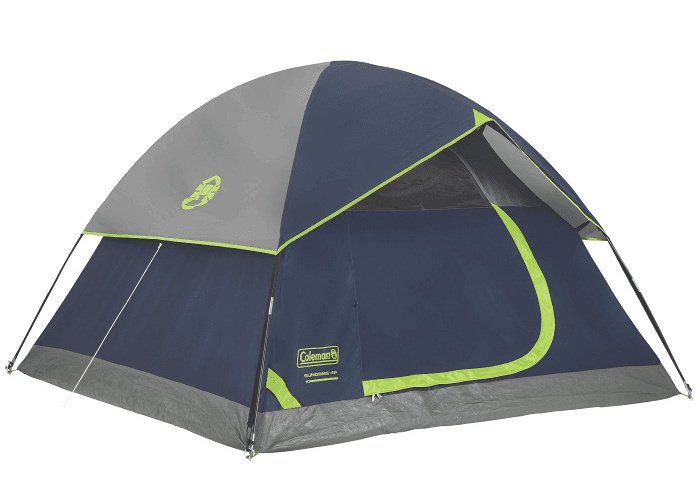
Pros
- Affordable
- Quick & easy set up
- Relatively lightweight & compact
- Includes all guylines
- Includes stakes & doormat
Cons
- Partial fly does not fully keep out rain
- Lower-quality poles & materials
- Not fully seam-sealed
- Single door
- Door zippers tend to snag on mater
- No vestibule
The Coleman Sundome 4 is the most affordable tent on this list. It’s popular because it’s so inexpensive (and almost always on sale somewhere) but is still relatively light and compact for its size. If you’re looking for a budget-friendly shelter for occasional camping on bluebird days and calm nights in the front country, the Sundome may be all you need.
Coleman keeps the weight of the Sundome down with lightweight fiberglass poles that create a simple and familiar structure. It’s straightforward to set up, and one person can pitch the tent in less than eight minutes, but an extra set of hands is helpful. An extended brow pole keeps the partial rainfly away from the windows, and a separate door mat is a welcome place to sit or stand while pulling on shoes or a jacket.
We appreciate the Sundome for its spacious interior. We easily fit three regular camping pads and a dog bed in the tent and had plenty of room to spread out. The peak height is just shy of five feet, so we couldn’t stand fully upright, but the lofty headspace is helpful for moving around.
For such a low price, though, you’ll sacrifice reliability and longevity. The poles and fabric of the tent are not durable compared to others on this list. We learned this when a pole broke and ripped through the fabric after a handful of uses in fair weather.
The budget-friendly price also means that most of the seams are not sealed, so this is not the tent to choose if there is moisture in the forecast – although it will dry fast after a passing rain cloud. The zippers on both windows and doors are clunky and tended to catch on the overlapping fabric. The partial rainfly attaches loosely to the frame with plastic hooks, and a single brow bar keeps the thin fabric balanced on top of the tent. A sustained moderate wind will unhook the rainfly from its position, so camping in anything but bluebird conditions may yield some interior moisture.
However, if you need a simple and inexpensive tent for a few nights of fair-weather camping here or there, the Sundome will do a fine job. For those who want an economical tent for an overnight in the backyard with the kids, a couple of mild weekends of front-country camping over a holiday weekend, or events like a multi-day festival, the Sundome is a decent option.
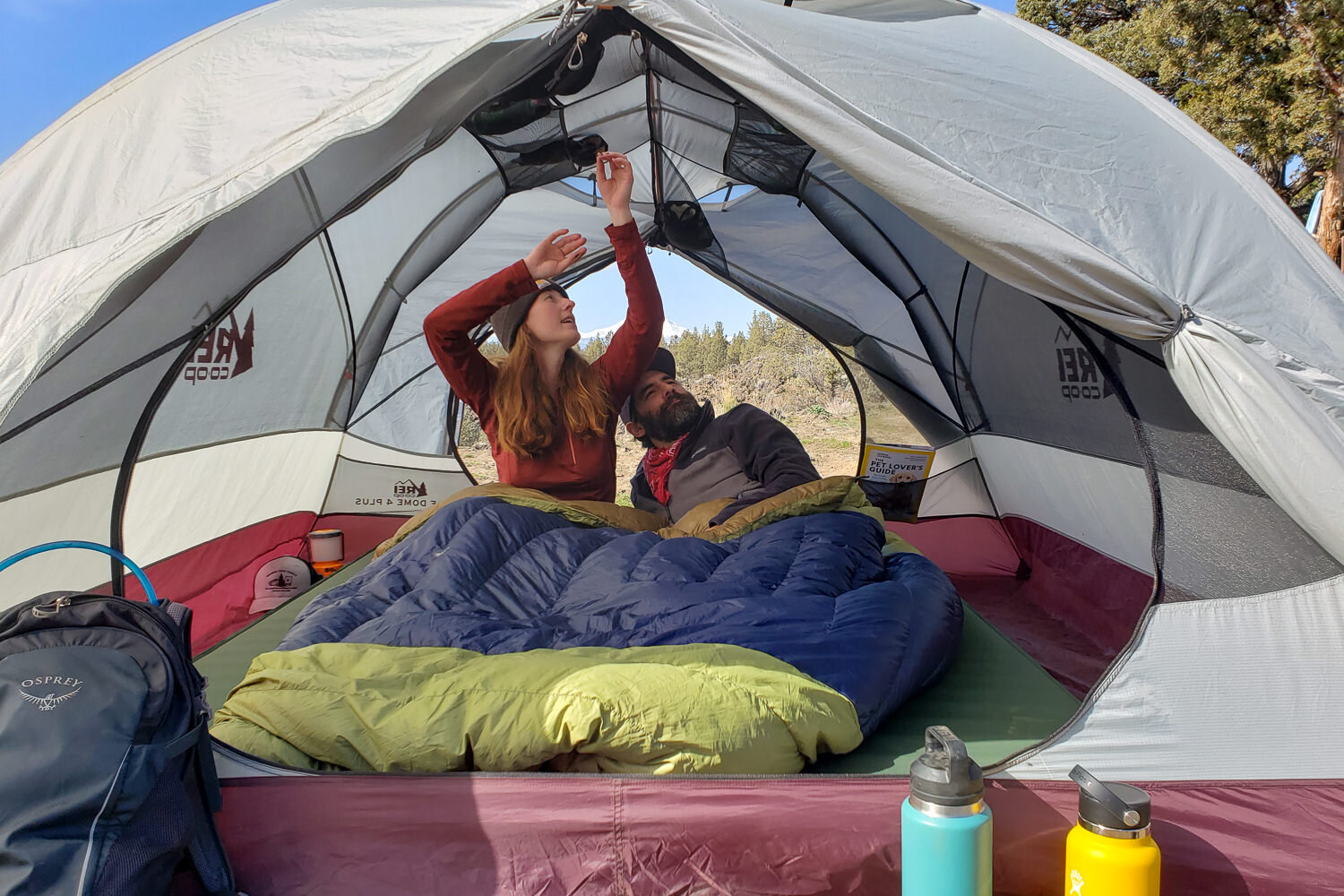
What’s Most Important To You In A Camping Tent?
PRICE
Camping tents can be expensive – some of the best cost as much as $700. But, your front-country castle doesn’t need to cost an arm and a leg for you to have a safe, fun, and comfortable camping experience. No matter what your budget is, we recommend camping tents at a variety of price points to get you out there.
Best value camping tents
Best luxury camping tents
Best budget camping tents
VERSATILITY
Some people like having a tent for each type of activity, while others want one tent that can do it all. If you were to take any of these tents, we highly recommend splitting the weight among those who plan to sleep inside it. If you’re only looking for lightweight and ultralight shelters for backpacking and less car camping, check out our guide to the Best Tents for Backpacking.
Tents that could work for both camping & backpacking
SPACE
How many people will typically be sleeping in your tent? Do you want the ability to stand up inside? For car camping, we always recommend getting one size bigger than what you truly need – for example, consider a 4-person tent to sleep two to three people, and a 6-person tent for four or more folks. Manufacturers typically overestimate how many people can comfortably sleep in any tent. Go big so you don’t go home earlier than planned.
Most spacious camping tents
EASE OF SETUP
Larger tents tend to have a more complicated setup process than small tents, but many of them are still easy to pitch. It’s always a good idea to practice setting your tent up for the first time at home to avoid confusion and frustration on your trip (not to mention having wifi in case you need a tutorial video).
Easiest camping tents to set up
WEIGHT / SIZE
Weight isn’t as important for car camping as it is for backpacking, since you’ll typically be setting up near your vehicle, but it’s still nice to have a tent that’s easy to maneuver and doesn’t take up a ton of space. If you have a small vehicle, limited storage space at home, or you’ll be venturing away from your parking spot, consider going with one of the lighter, more compact tents.
Best lightweight & compact tents
Best mid-size/weight tents
Best heavy-duty tents
Critical Camping Tent Considerations
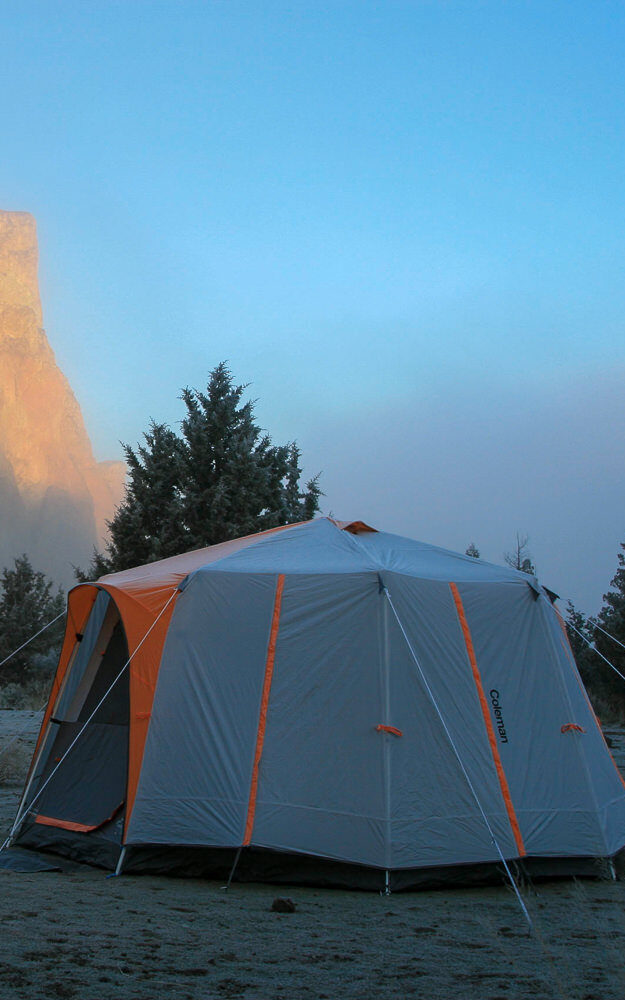
CHOOSING A TENT SIZE
Capacity ratings usually overstate the number of people (and sleeping pads) that fit in a tent, so don’t rely on that number unless you enjoy sleeping like sardines. A good rule of thumb is to go up in size by one or two people for additional space and more comfort. If you’re tall, claustrophobic, or you share a tent with children or pets, a little extra elbow room will make your trip much more enjoyable. You could also consider using multiple small tents in place of one large tent to accommodate groups. In our experience, kids are typically stoked to have their own tent. If you’re unsure what size will work best for your group, check out our Tent Size Guide.
PEAK HEIGHT
If you’re camping for multiple days, spend a significant amount of time hanging out in your tent, or use it a lot in a season, choose one that’s tall enough to stand and move around in. Tents with high peaks and near vertical walls have the most usable space, but they are more susceptible in windy and stormy conditions. Be sure to use the appropriate stakes and guylines to help support larger tents and avoid issues.
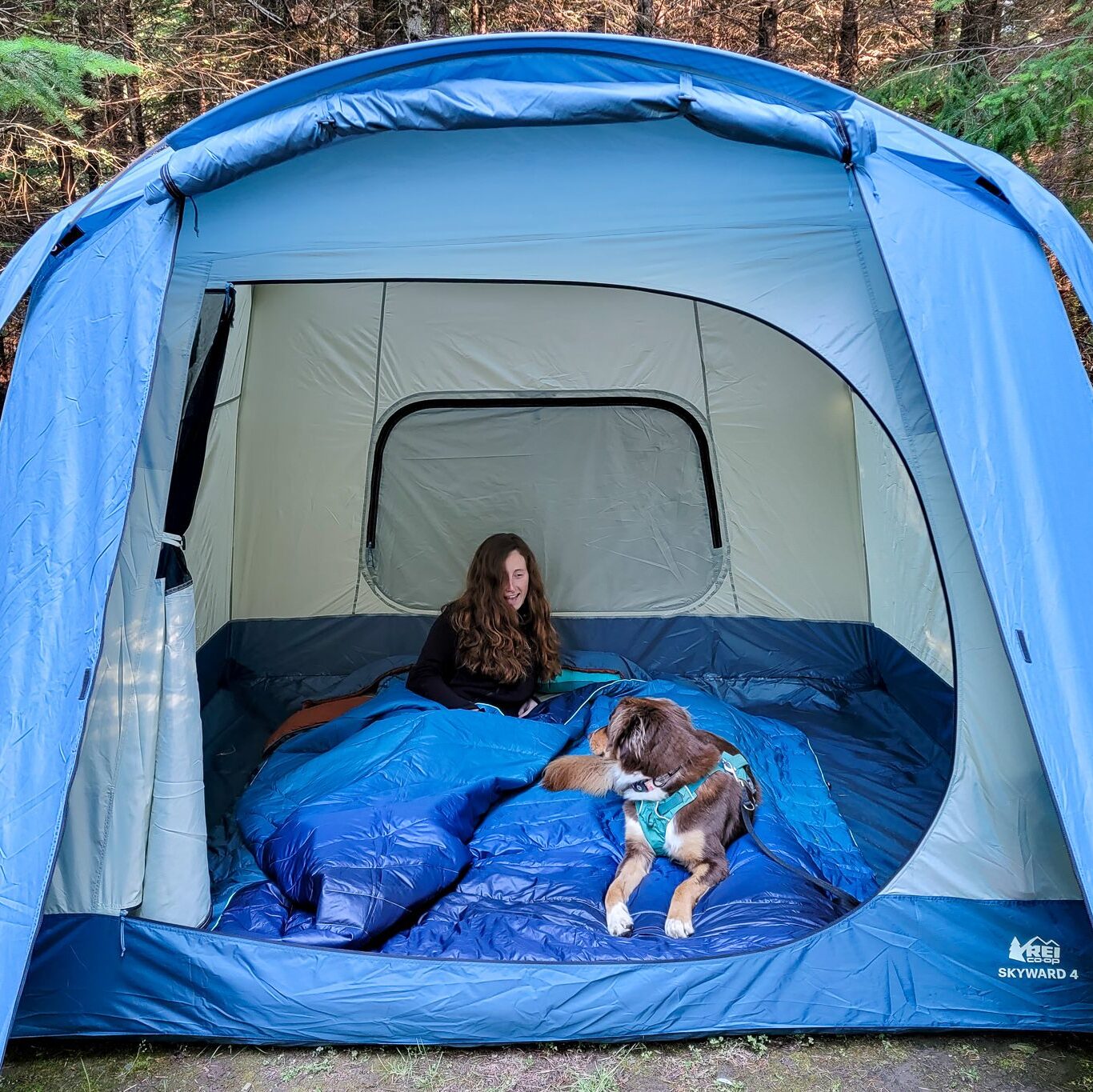
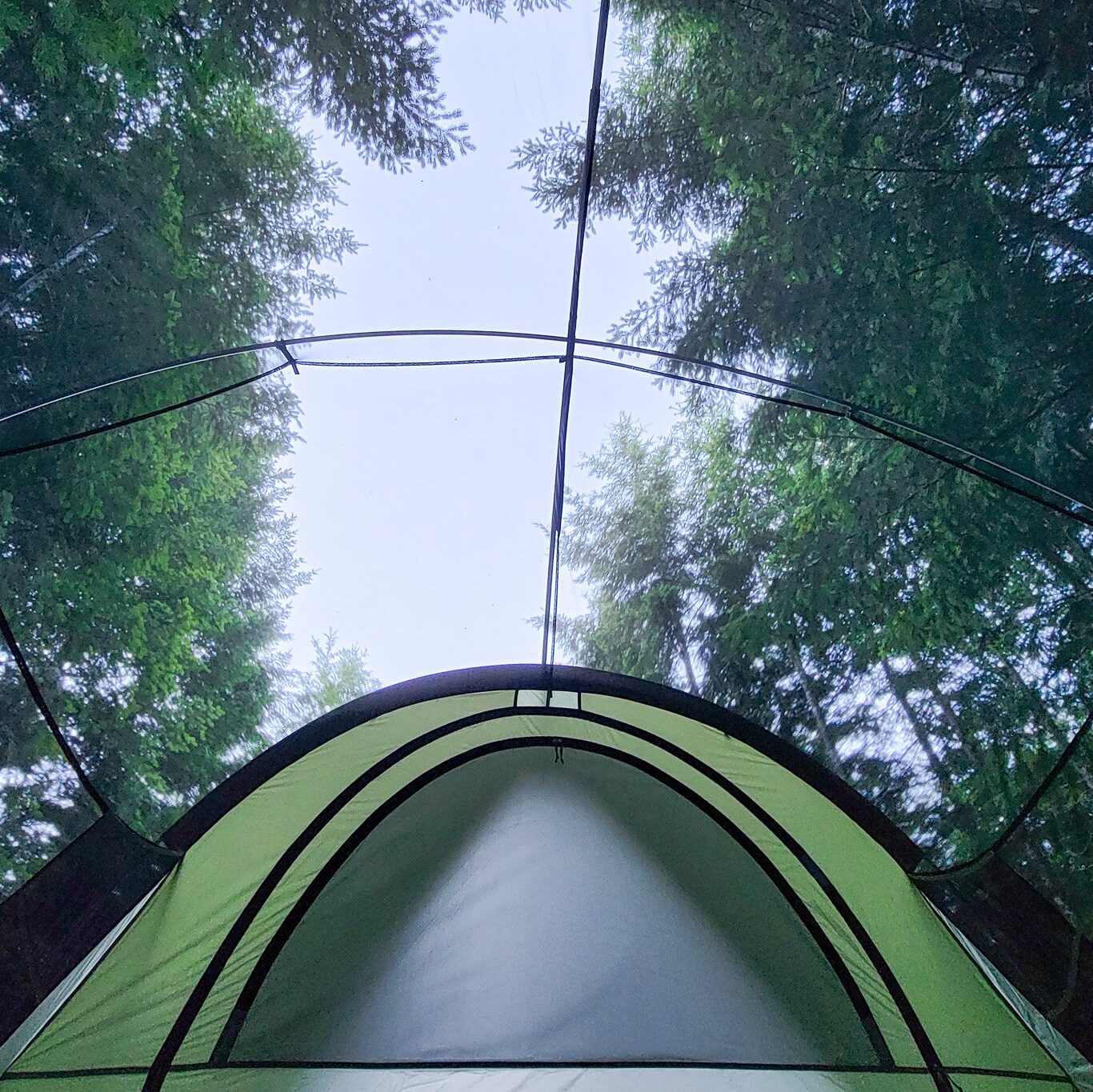
VENTILATION
Good ventilation is important for controlling internal condensation. Look for tents designed with adequate roof vents that allow fresh air to circulate, rain or shine. It’s not much fun being cooped up in a muggy tent without functional vents when the weather turns foul or the temperatures fluctuate. Some tents have zippers that allow you to access top vents with kickstands from the interior of the tent, which comes in handy when high roofs are hard to reach on the outside. Be sure to stake out the sides of your rainfly for better air circulation.
NUMBER OF DOORS
We think multiple doors is a must for group camping. The freedom to enter, exit, and access gear in the vestibules without disturbing your camping crew makes overnight adventures far more enjoyable. Adequate doorway and vestibule space are essential when it’s rainy and everyone wants to clamber into the tent to get out of their wet or dirty clothes as quickly as possible.
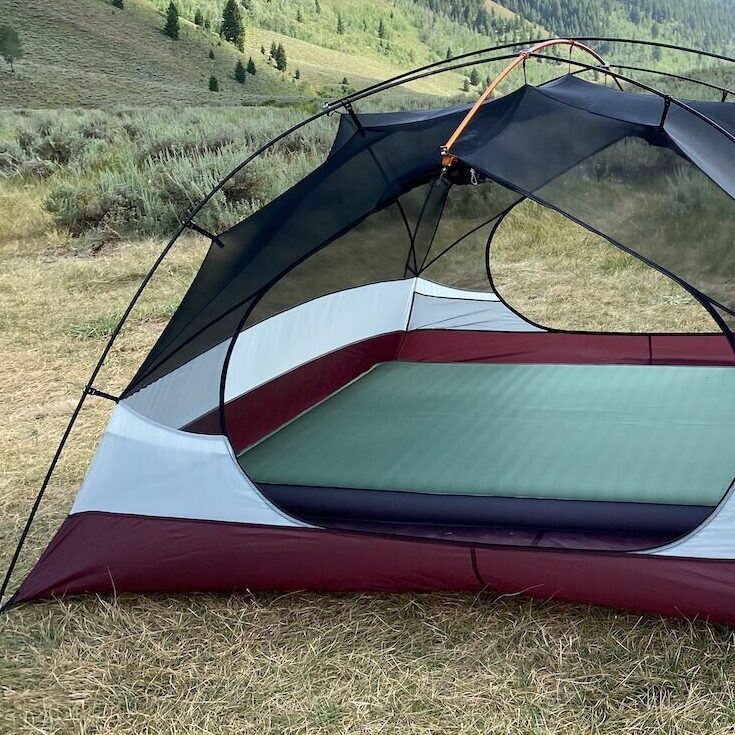
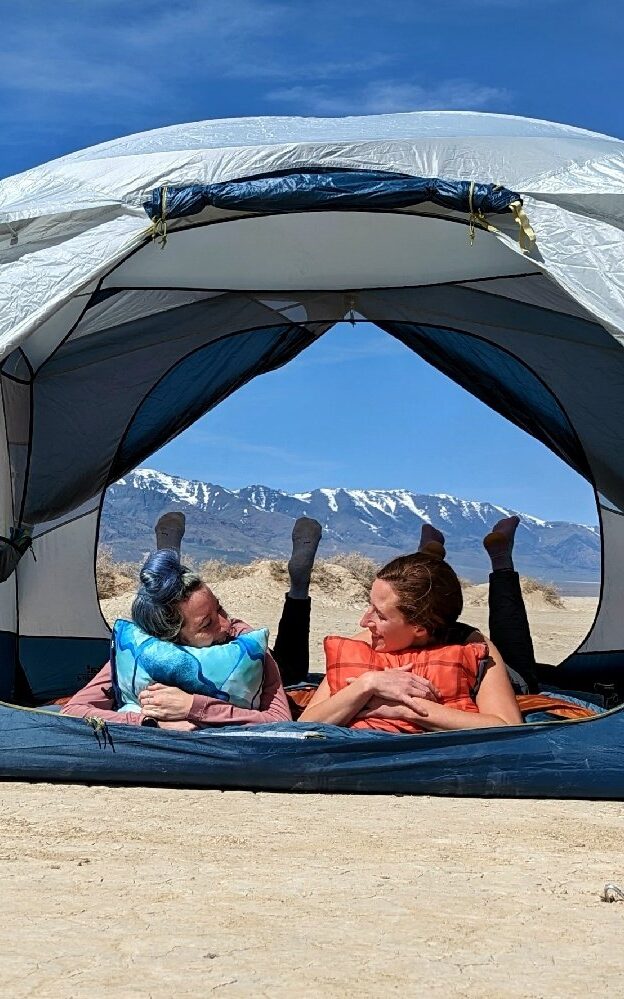
EASE OF SETUP
Setting up any tent for the first time can be a challenge, but it always gets easier with practice. Many tents are designed to be intuitive and quick to pitch with color-coding poles, buckle clips, and simple, user-friendly directions. Be sure to choose a tent that’s a manageable size and weight for you to handle easily, especially if you’ll be pitching it alone. Large tents can be awesome, but don’t choose one that’s so complex that it takes all the fun out of camping, or requires multiple hands to pitch.
VESTIBULES & AWNINGS
Vestibules are covered areas outside your tent doors meant for protecting and storing gear like backpacks and shoes – so you keep the bulk and mess outside of your sleeping area. If you plan to camp in places where it rains often, make sure your tent has one or more big vestibules so you won’t have to bring wet or muddy gear inside your sleeping area. Some vestibules can also be converted into awnings for shade using pole accessories (not included). Other campers bring a separate shade or screen house that can be set up away from their tent, while others prefer to use an awning directly attached to their tent like a porch.
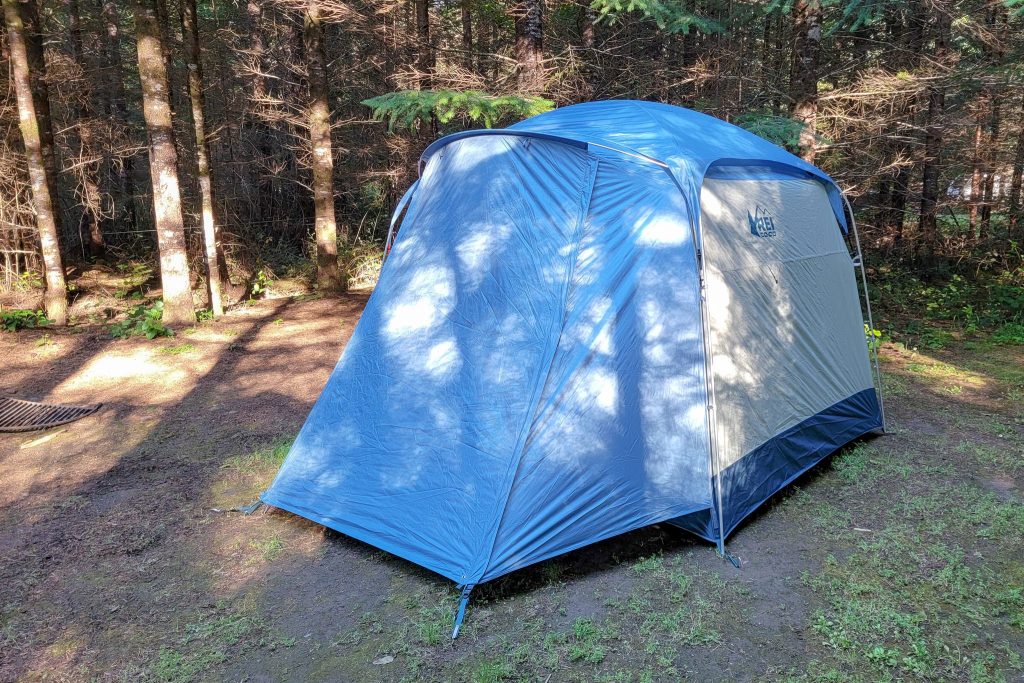
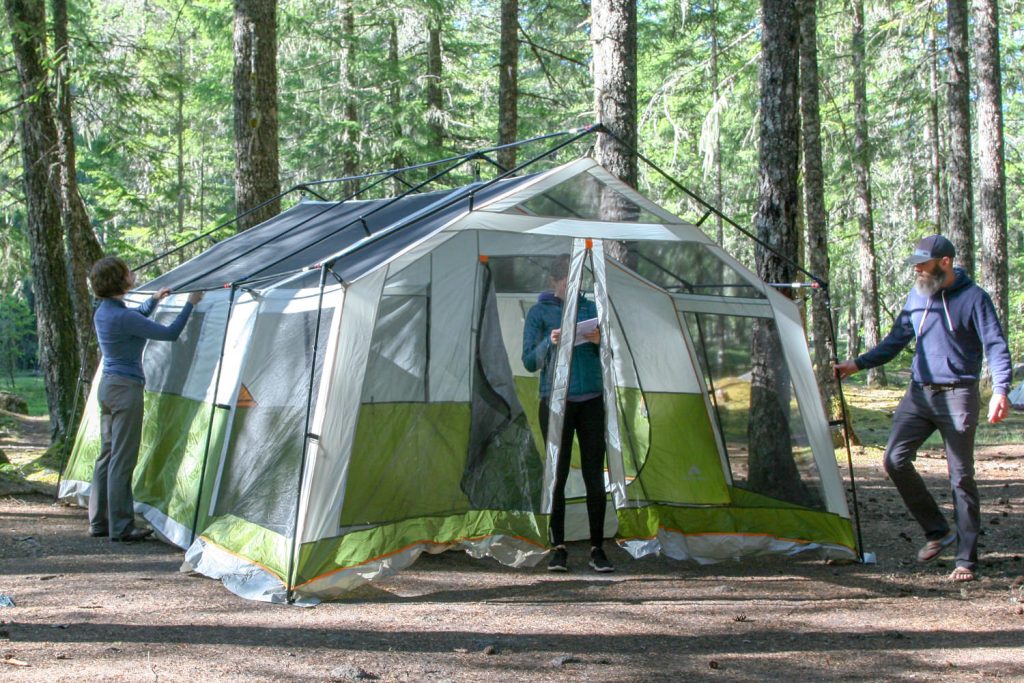
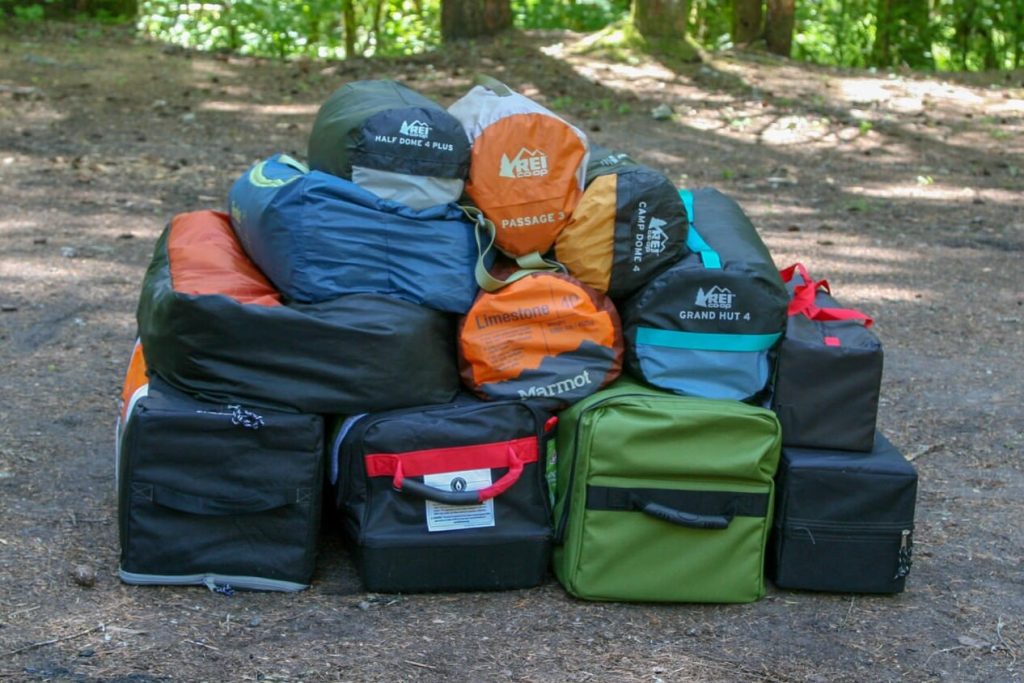
PACKED SIZE
The packed size of your tent is vital for backpacking, but it’s not as important for car camping. Still, it’s smart to consider how much space you’ll have for your gear in your car and at home. A compact tent will be far less cumbersome to maneuver.
SEASON RATINGS
3-Season Tents
3-Season tents are the most common type of tent and are typically meant to be used during the summer months when the weather is fair. These tents tend to have good ventilation and will protect you from rain and insects, but they may not be robust enough to withstand intense storms with heavy rain or high winds.
3-4 Season Tents
Some 3-season tents can be used from early spring through late fall, where the signs of winter are still obvious. They’re designed with more weather protection in mind and seek to offer a balance of ventilation, strength, and heat retention. These tents are often dome-shaped to shed rain and light snow with slightly more robust poles to give the structure rigidity to withstand winds. The rain fly will usually be more full-coverage and extend almost to the ground with one or more vestibules to keep gear and shoes dry.
4-Season Tents
4-season tents are best for those who plan to camp in snow and inclement weather, but they’re overkill for most 3-season car campers since they’re generally much more heavy and bulky. They tend to have lower-profiles and are dome-shaped to shed snow and high winds. The biggest downside of 4-season tents is they have much less ventilation, which can make the living area too warm and stuffy in warm conditions. Save the 4-season tents for winter camping or extended trips in heavy rains when it’s critical to have a warm, safe shelter.
PACKAGED WEIGHT VS. MINIMUM TRAIL WEIGHT
Different websites list different specs for tent weight, and it can be confusing if you’re unsure of the terminology. Unfortunately, there’s no set standard for measuring the weight of tents across the industry – so your confusion is warranted – but we’ve got a few tips to help you navigate measurements:
Packaged Weight – This is the number we use to measure total tent weight in this guide. Packaged weight represents the weight of all parts of your tent plus included accessories at the time of purchase. This is the most accurate measurement since it includes everything you’ll need to pitch your tent.
Minimum Trail Weight – This spec represents the minimum components you’ll need to stay dry in a storm. It usually includes the tent body, rainfly, and poles, but depends on the tent model and what the manufacturer deems “minimum” or “necessary”, so this measurement is less reliable than Packaged Weight. This spec leaves out the weight of the stuff sacks, guy lines, and tent stakes (unless your tent is semi-freestanding).
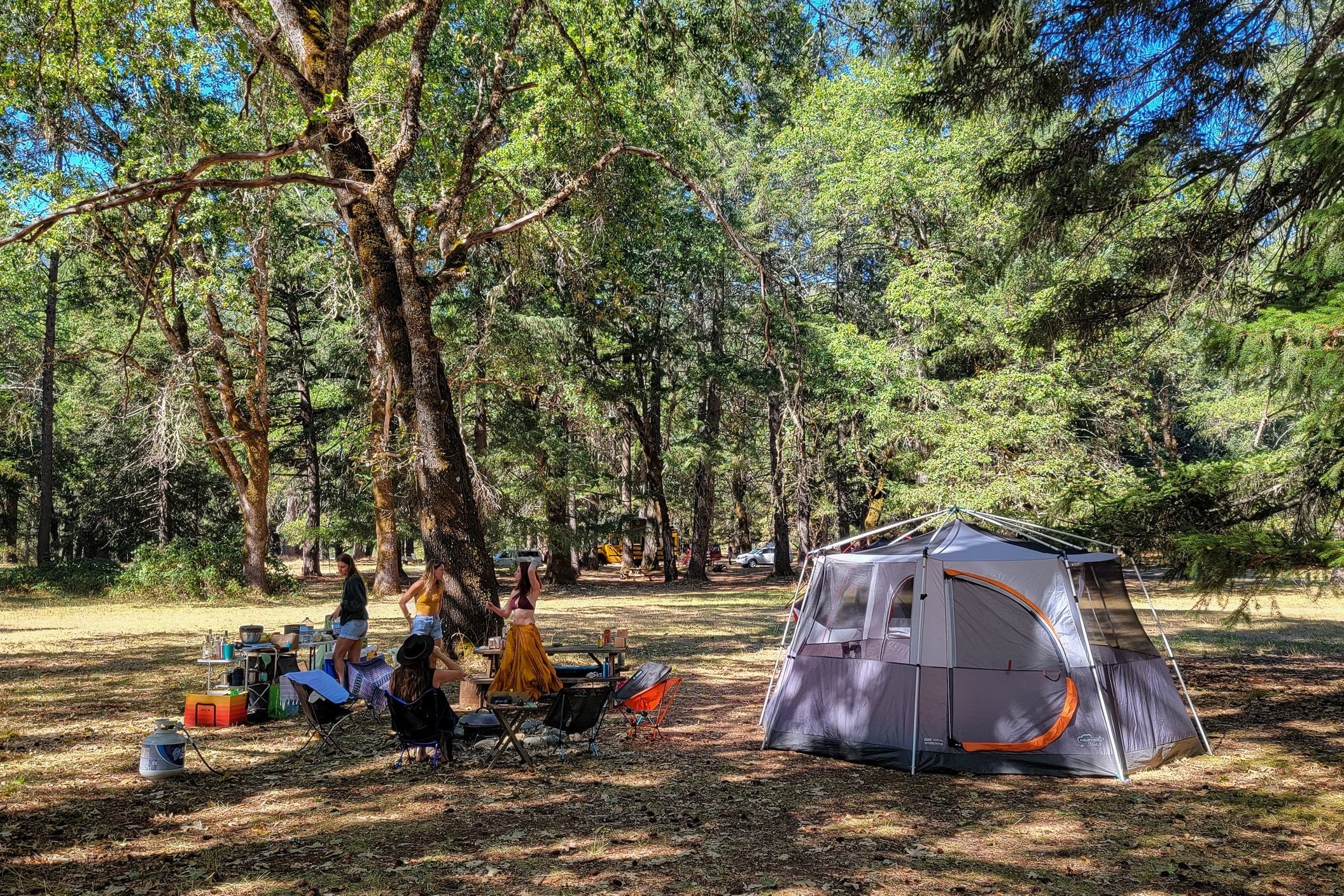
Getting the Most Out of Your Tent
FOOTPRINT
If you’re spending a significant amount of money to buy a quality tent, it’s well worth investing in a footprint to extend the life of the fabric. The footprint is a lightweight material that adds just a bit of extra material to increase the durability of your tent floor and add a bit of an extra buffer between your home in the woods and poky branches, sharp rocks, or rogue thorns. If a specific footprint isn’t available for your tent model, a generic one will do. Just make sure the footprint you get is the right size – a footprint that’s too large can collect water and cause it to pool under your tent, and a footprint that’s too small won’t provide adequate coverage. Check out our post Do You Really Need a Footprint? for more information.
USE STAKES & GUYLINES
Fully staking out a tent maximizes interior space and makes the tent more sturdy. Taking a few extra minutes to completely stake down and guy-out your tent could mean the difference between your tent lasting for years, or rolling away in the wind and ripping to shreds. If your guylines didn’t come pre-attached, the best way to attach them to the rainfly is with a bowline knot.
If your tent has a lot of guy lines and stake-out points, consider bringing a small mallet to make the staking process quicker and easier. Many camping tents don’t come with enough stakes and guylines for all of the guy-out points, so it’s a good idea to pick up some extra guy lines and tent stakes at the time of purchase or immediately afterward.
WATERPROOFING
Most high-quality tents come fully seam-sealed to prevent water from penetrating where the fabric has been stitched. If the instructions tell you to seal all the seams to increase weather protection, that means the tent isn’t storm-proof – yet.Seam sealing isn’t difficult, but it can be time-consuming and somewhat tedious, especially on a large tent. If your tent was once seam-taped, but you’ve noticed it starting to leak, it might be time to do some maintenance to extend the life of the tent by waterproofing it properly, including sealing the seams, replacing a peeling polyurethane coating, and refreshing the DWR coating on the rainfly.
Honorable Mentions
These camping tents have a lot of good things going for them and one of them might be just right for you and your family:
This tent is an excellent family option that boasts a ton of interior space. We love the easy setup, the large vestibule with a door that rolls completely out of the way, and the smart pocket locations. Thanks to clever vent placement and airy fabrics, the Base Camp is great at condensation management and feels cool and airy on even the warmest days.
The affordable option is a stellar budget tent for individuals or couples who want a practical camping tent that’s easy to pitch. The Trail Hut is very affordable but has some of the same features as more expensive tents like two wide doors, double vestibules, and good vents. It’s lightweight and compact enough that it could be used for backpacking trips.
